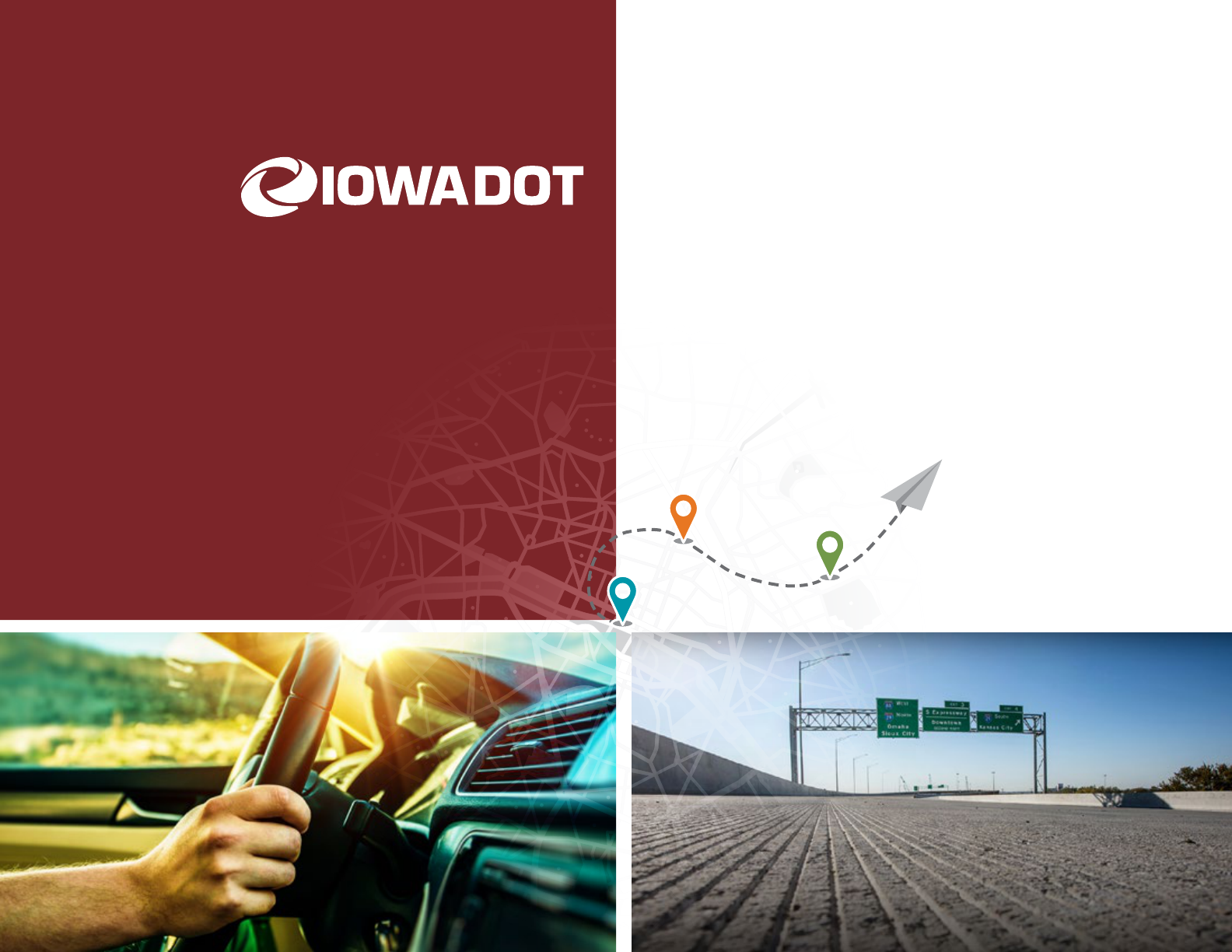
January 2021
20212025
IOWA DOT
BUSINESS PLAN
MAKING LIVES
BETTER THROUGH
TRANSPORTATION
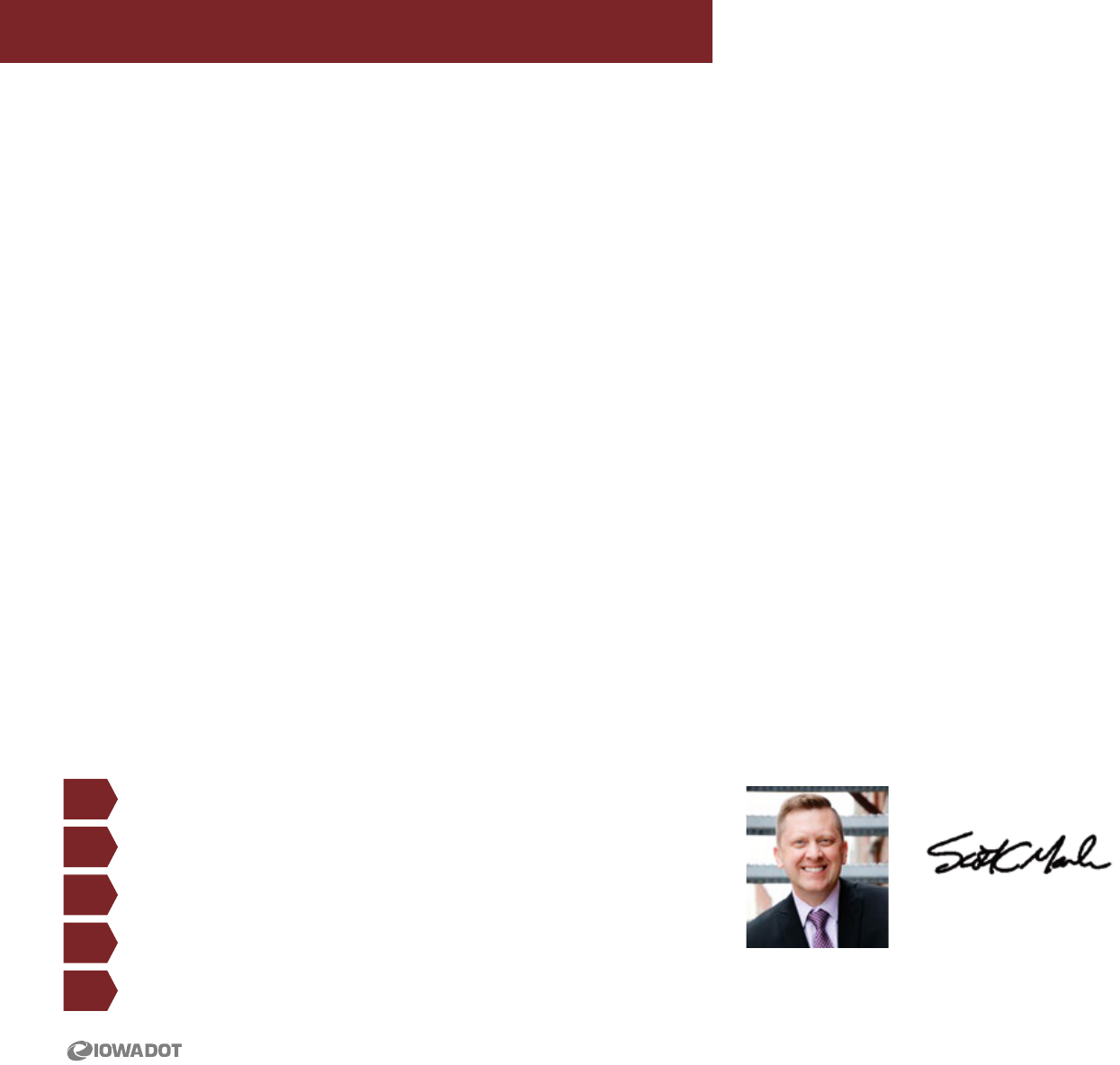
| BUSINESS PLAN | JANUARY 2021
MESSAGE FROM THE DIRECTOR | i
MESSAGE FROM THE DIRECTOR
This Business Plan guides actions of the Iowa Department of Transportation over the ve-year period of 2021-2025 to achieve our
preferred future. The plan was developed by Iowa DOT’s Executive Leadership Team (ELT) to emphasize internal improvements and
align with other long-range and modal plans.
The Business Plan outlines activities to position the Iowa DOT to meet the demands of today and challenges of tomorrow. It
specically assesses where we are, where we are going, and how we are going to get there. Our people, culture, and safety-focused
core values position us to continuously improve our organization as we serve Iowa.
Where are we?
Iowa DOT has a rich history dating back to its start as the Iowa State
Highway Commission in 1904. Over more than a century, Iowa DOT has
evolved to be a national leader in many areas including safety, long-range
planning, and asset management. Yet the crossroads we’re at challenges
us with trac fatalities, maintaining mobility for our economy, technology
disruption, outdated systems and processes, changing workforce, and so
much more. We must continually improve our way of doing business and
evolve as an organization.
Where are we going?
The future is bright and we have many opportunities ahead of us. Whether
it’s adapting to rapidly changing technologies, maintaining top-notch
customer service, or sustaining a highly capable workforce, we must adapt
to changing customer needs.
Five priority goals have been established to drive our organization:
Improve Transportation System Safety & Performance
Improve Customer Service
Advance Workforce for Future Challenges & Opportunities
Secure Stable & Sustainable Funding
Grow Innovation
How are we going to get there?
As we start on this journey of evolving our organization to more eectively
meet customer needs, we will introduce sta at all levels to new tools
and terminology to help us better connect our long-range plan with
the services we provide to our customers. We are aligning our strategic
direction, this Business Plan, and the eorts of every unit and individual
throughout our organization.
As we meet our challenges through agility and innovation, I am condent
Iowa DOT will provide the most customer-focused, safe, reliable, and
ecient transportation system and services in the nation.
As Stewards of Iowa’s Transportation System, we are in a unique and
privileged position to connect communities, people, services, and goods
to advance our state. We have the opportunity to truly make people’s lives
better through transportation… I can’t imagine a better outcome than that.
I look forward to taking the next steps with you together, to evolving as an
organization, and to creating that preferred future that we all seek.
Sincerely,
Scott Marler
Director, Iowa DOT
1
5
4
3
2
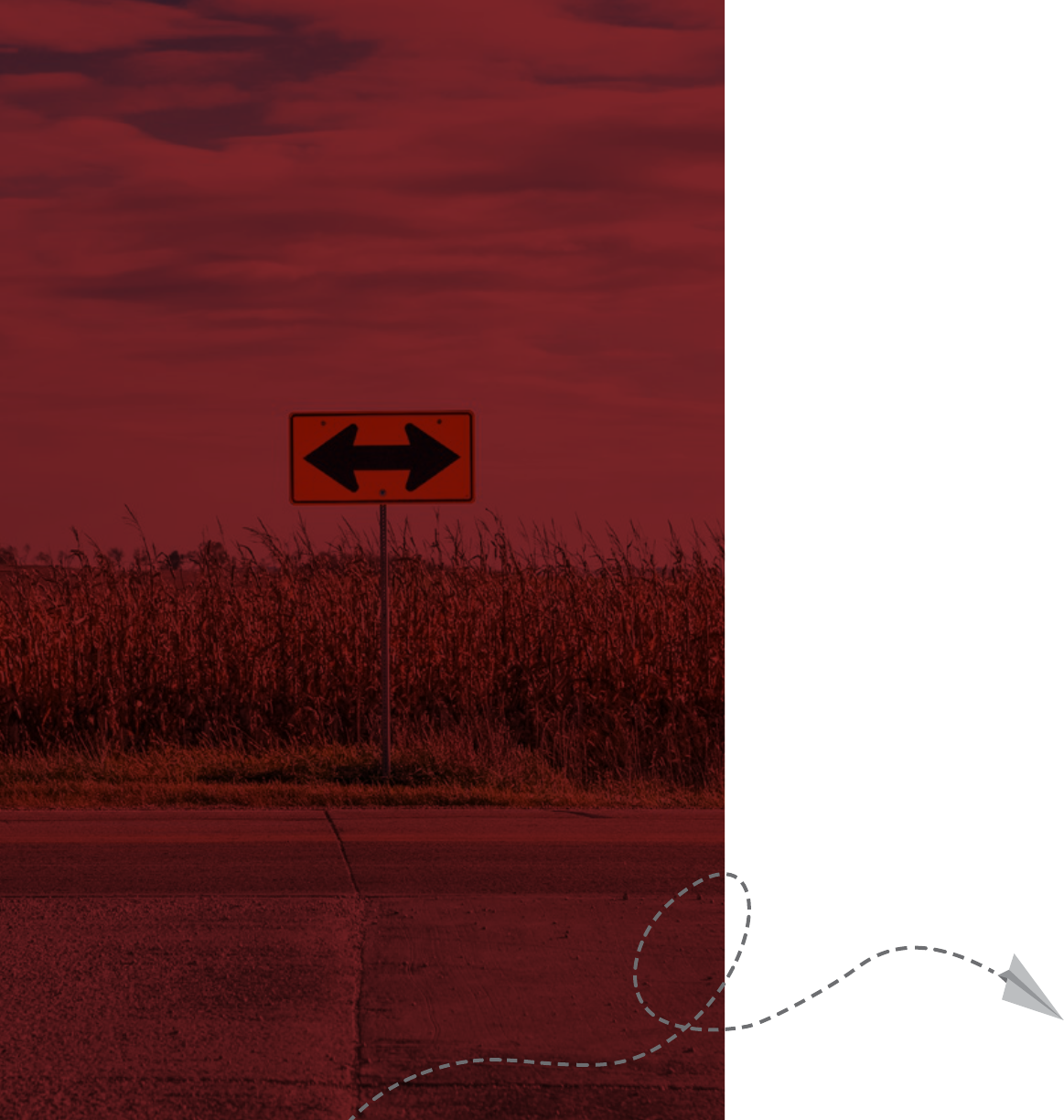
Executive Summary ................................ 1
Where We Are...................................... 3
Business Plan Overview
Previous Direction
Strategic Alignment
Where We’re Going................................. 8
Values & Focus
5-Year Priority Goals
5-Year Picture
1-Year Objectives
How We Get There.................................. 15
Implementation Approach
Implementation
Appendix ......................................... 22
Vision / Traction Organizer
EOS Terms
Iowa DOT Operating Handbook
CONTENTS
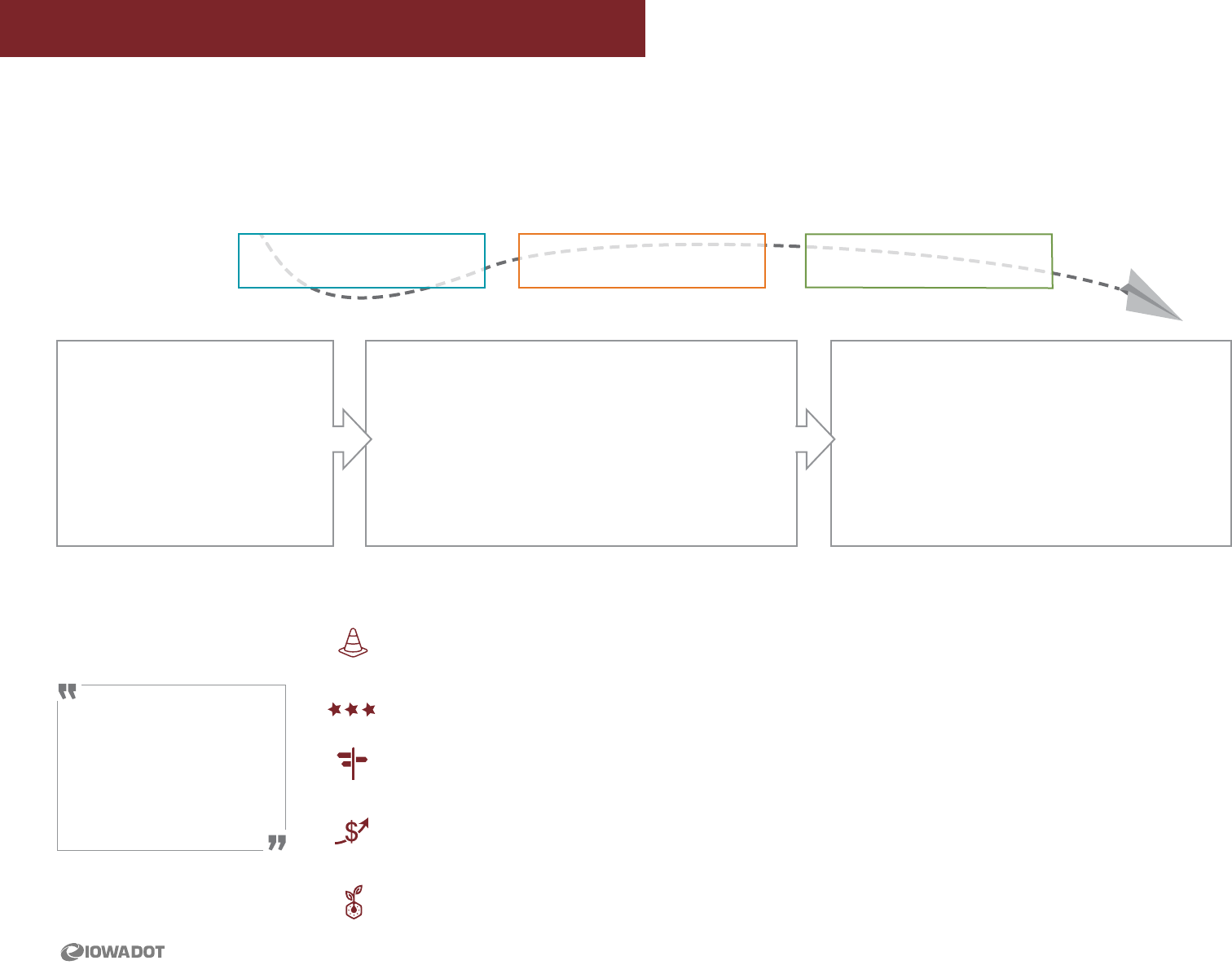
EXECUTIVE SUMMARY | 1
| BUSINESS PLAN | JANUARY 2021
EXECUTIVE SUMMARY
2021-2025 Iowa DOT Business Plan
Iowa DOT’s Business Plan represents a new way of doing business and was developed to eect change and improvement toward DOT’s vision for a better
future. With strategic direction guided by the State Long-Range Transportation Plan, the Business Plan outlines nearer term focus with tools to bring the DOT’s
vision from ten years all the way down to the highest priority quarterly actions known as 90-Day Rocks.
Innovation is real work,
and it can and should be
managed like any other
corporate function.
Peter Drucker
Where We Are Where We’re Going
How We Get There
The Business Plan Comprises Three Sections
Iowa DOT’s Vision
Our Core Values
Safety First
People Matter
Customer Focused
Servant Leadership
Integrity Without Exception
10-Year Target
The preferred future for Iowa DOT is to be:
Safest - Smartest -
Made to Last
Iowa has the most customer-focused, safe, reliable,
and ecient transportation system and services in
the nation through agility and innovation.
Our Core Focus
Making Lives Better Through
Transportation
Serving the people and businesses of Iowa, the DOT’s
unique niche as Stewards of Iowa’s Transportation
System contributes to the State of Iowa’s Core Purpose of
Enhancing the Quality of Life for Iowans.
Our 5-Year Priority Goals
Iowa DOT leadership has prioritized ve Priority Goals as the overarching direction for the Business Plan:
Improve Transportation System Safety & Performance
Outcomes include: zero fatalities in work zones, total trac fatalities signicantly reduced, increased
eciency, reliability, resiliency, and condition of our transportation system
Improve Customer Service
Outcomes include: greater levels of customer satisfaction across all programs and services
Advance Workforce for Future Challenges & Opportunities
Outcomes include: engaged and empowered employees, increased diversity, equity, and inclusion, and
steady reductions in turnover rate (non-retirement)
Secure Stable & Sustainable Funding
Outcomes include: implemented funding strategies, ensured diversied funding mechanisms, and
reduced technical debt (e.g., legacy systems)
Grow Innovation
Outcomes include: adopted smart technologies, culture of innovation, and modernized systems
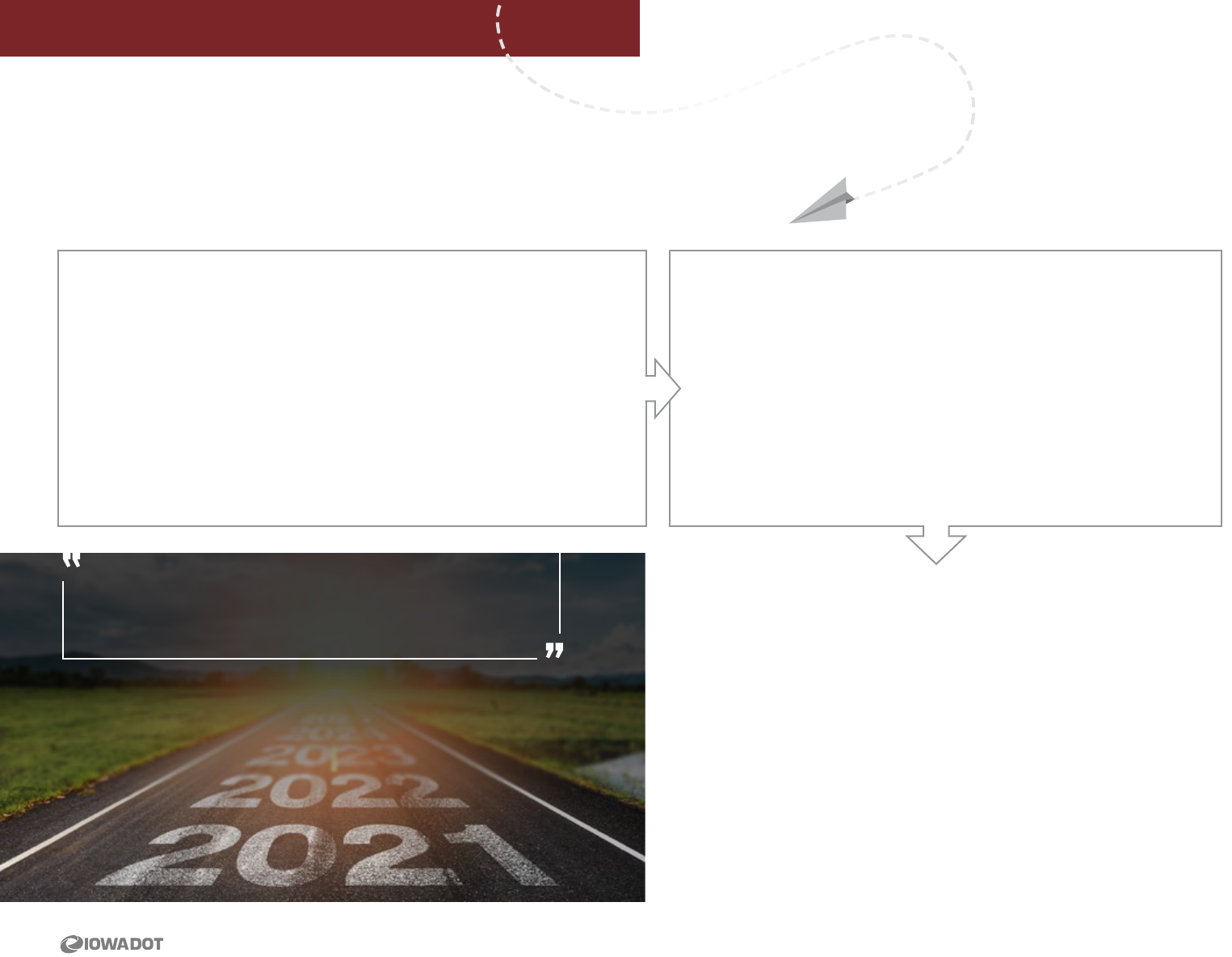
EXECUTIVE SUMMARY | 2
| BUSINESS PLAN | JANUARY 2021
EXECUTIVE SUMMARY
While the Business Plan is reviewed and updated every other year,
implementation is achieved through specic quarterly and biweekly
eorts among all Divisions. The Business Plan adapts several tools from
the Entrepreneurial Operating System (EOS), such as:
Meeting Pulse
Annually, rearm Priority Goals and prioritize objectives for the year
ahead; quarterly, review the Vision / Traction Organizer (V/TO) and prior
Rocks, set new Rocks, resolve issues; and biweekly, Level 10 meetings
Level 10 Meetings
Structured, high-value, 90-minute meetings that review Rocks and
Scorecard, and resolve issues
90-Day Rocks
Prioritize 3-7 items to accomplish in next 90 days, every Rock has an
owner, and every Division and most Bureaus have Rocks
Implementation & Traction
A vision is not just a picture of what could be; it is an appeal
to our better selves, a call to become something more.
Rosabeth Moss Kanter
Where We’re Going as an organization is centered on the Priority Goals over the next ve years. How We Get There involves an
action-oriented implementation approach and set of tools for identifying 1-Year Objectives each calendar year, assigning ownership
for 90-Day Rocks, and adhering to a cadence of ecient meetings and accountability for Rocks and key business metrics.
1-Year Objectives for 2021
DOT leadership has set ve Objectives for calendar 2021, and every
year hereafter new or rened 1-Year Objectives will be set.
1. Reduce Fatalities to Under 300
2. Update Organizational Structure & HR Business Practices to Align
with Organizational Strategies
3. Implement New Customer Feedback Programs
4. Reimagine How We Invest in Technology
5. Implement Business Measures that Move Us Forward
5-Year Picture
By December 31, 2025, transportation throughout Iowa will be safer and
performing better, with fatalities signicantly reduced and a more resilient,
reliable, and ecient system. Our internal and external customers will be
better served, employees will be more engaged, and customer satisfaction
across all programs and services will be increasing. Empowered employees
will be well-equipped to meet both the challenges and opportunities of the
future, and a culture of innovation and modernization will be integrated
throughout the DOT. As stewards of Iowa’s transportation system we will
have addressed our greatest resource needs and identied new, stable, and
sustainable funding to ensure our transportation system is well-maintained.
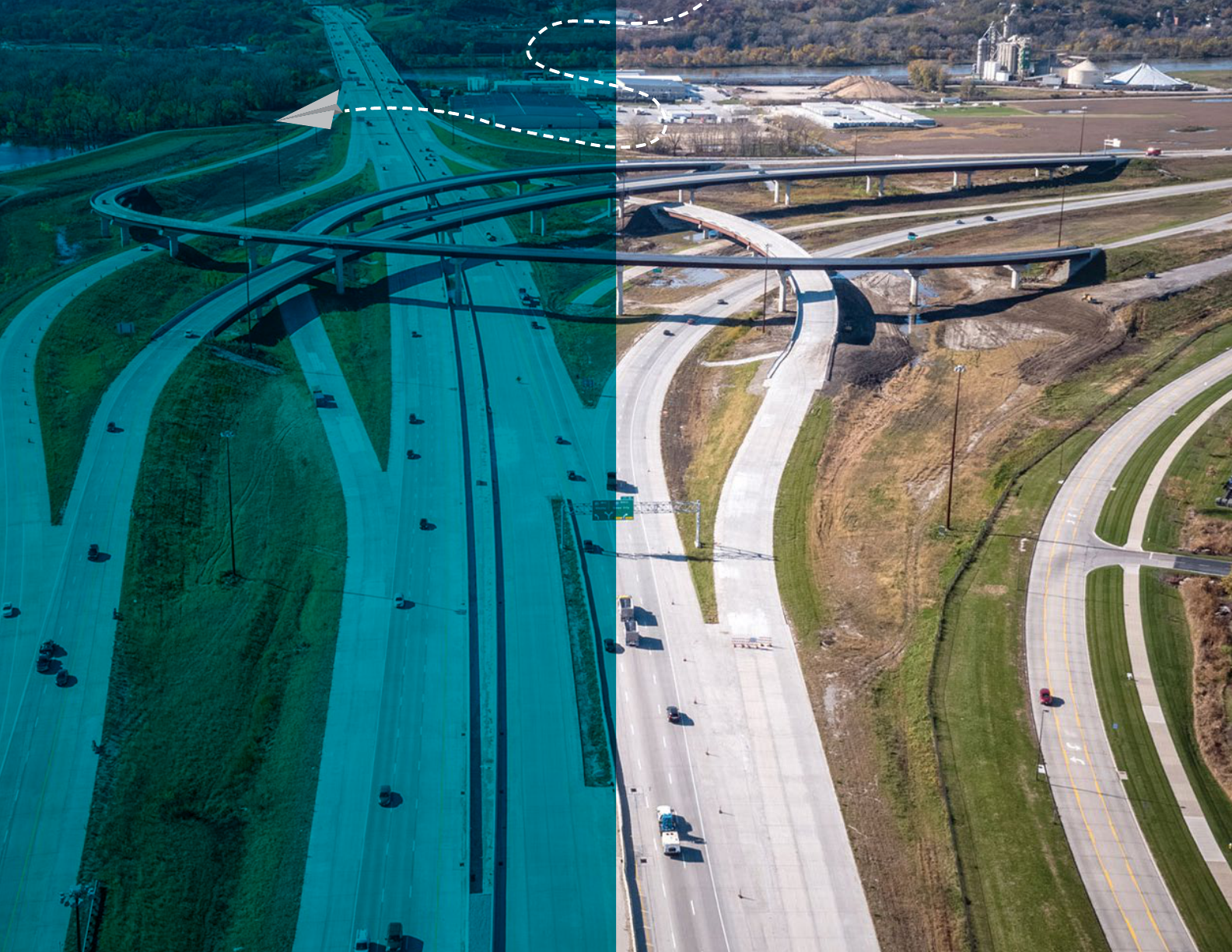
EXECUTIVE SUMMARY | 3
| BUSINESS PLAN | JANUARY 2021
WHERE WE
ARE
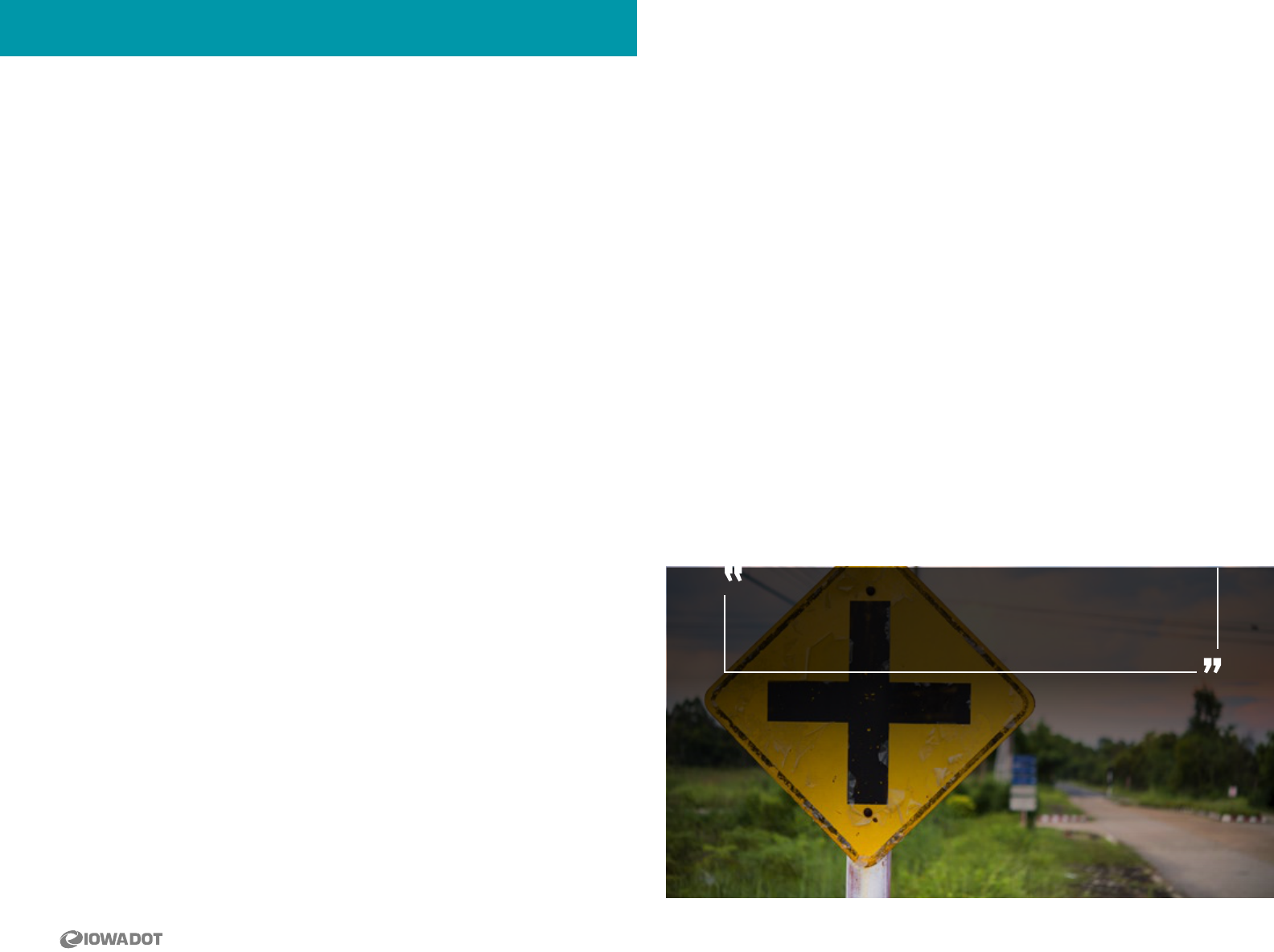
WHERE WE ARE | 4
| BUSINESS PLAN | JANUARY 2021
WHERE WE ARE
Business Plan Overview
This Business Plan guides actions of the Iowa Department of Transportation over the 2021-2025 ve-year period to achieve our
highest priority goals. The Department-focused plan was developed by Iowa DOT ’s Executive Leadership Team (ELT) to emphasize
internal improvements and align with other long-range and modal plans. The Business Plan positions the Iowa DOT to meet the
demands of today and challenges of tomorrow.
At a Crossroads
Large organizations like the Iowa DOT operate in an increasingly dynamic
external and internal environment, making adaptation and business
planning essential. Currently, the Department is at a crossroads and has
both challenges and opportunities.
Some of our key opportunities include:
• Supporting economic growth
• Leveraging and adapting to rapid technological change
• Managing our transportation assets as well as we possibly can, with
increasing emphasis on stewardship and operations
• Continuously preparing and equipping our workforce
Likewise, we have some intersecting challenges that demand our
attention:
• Reducing trac fatalities across our state
• Moving beyond organizational silos to be as seamlessly eective as
possible
• Improving our performance and how we communicate for continuous
improvement
• Eectively managing and making the best use of data in a data saturated
world
• Addressing the transportation system needs with funding limitations
• Modernizing our systems and processes for the 21st century
• Recruiting and retaining a workforce to meet the challenges of the future
Recognizing that we’ve made great strides in many areas as an agency
to date, we nd ourselves at a crossroads, and now is the time to open
ourselves to change and choose to become a better version of ourselves
for the future. We can envision a future that is brighter, where there are
fewer trac fatalities, all people arrive at their destinations safely and
eciently, and our workforce is agile and empowered, working together to
evolve and improve our organization. We will look back at this crossroads
and take great satisfaction in the changes we brought about, the new
thinking and ideas put into motion, and the goals that we achieved.
Progress is impossible without change, and those who
cannot change their minds cannot change anything.
George Bernard Shaw
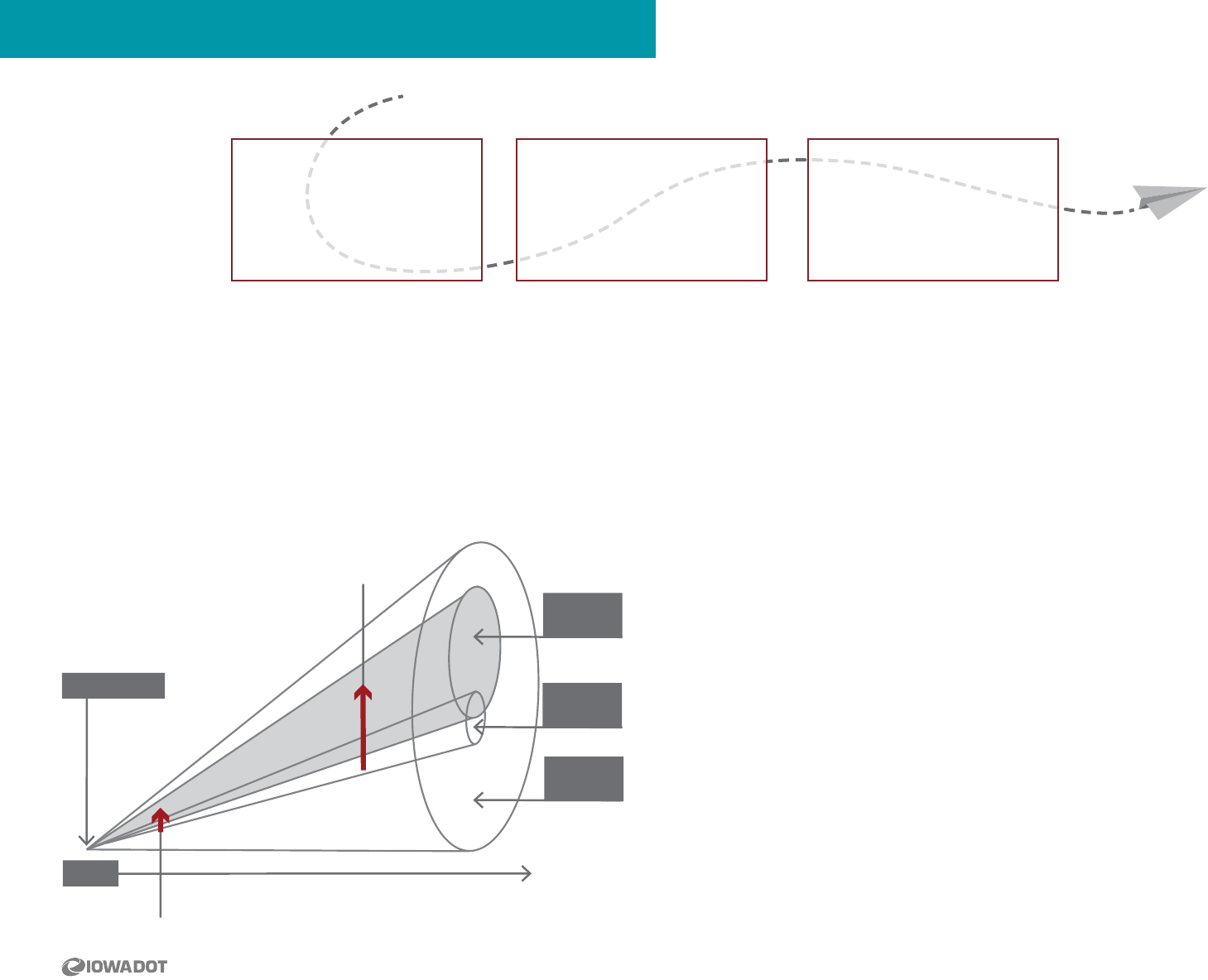
WHERE WE ARE | 5
| BUSINESS PLAN | JANUARY 2021
WHERE WE ARE
The purpose of this Business Plan is to guide positive change now to
achieve Iowa DOT’ s preferred future. Iowa DOT’s Business Plan has
been designed to achieve these principles:
• Provide Leadership on Emerging Statewide Transportation Issues –
At a crossroads in America’s heartland, Iowa faces transportation
responsibilities, challenges, and opportunities related to moving people
and goods. These are linked to myriad issues: safety, stewardship,
resilience, equity, climate change, land use, economic development, and
others. Change takes time and must be acted on in the present.
• Position the Iowa DOT for Change – The Business Plan helps guide
positive change at every level. Its structure ensures a balance of eort
between customer service delivery, operations, and resources.
• Develop and Align the Organization – The Business Plan supports
the need to continuously communicate strategic direction and improve
internal operations of the organization to meet the DOT’s purpose.
• Manage Proactively – Eective management is built on enhanced
systems, processes, and controls within the organization to ensure
strategic, future-looking actions are integrated with day-to-day activities.
Problems and opportunities are anticipated and the DOT is prepared to
address each.
• Execute Long-Range Strategic Planning – The Business Plan supports
implementation of Iowa’s Long-Range Transportation Plan by laying out
the execution process in achievable and actionable annual and quarterly
steps.
• Foster Innovation – Objectives in the Business Plan encourage
innovative approaches and serve as a guide for the organization.
Importantly, the execution of many of the plan’s actions will grow our
culture of innovation.
• Strengthen the Iowa DOT as a Regional Asset – We have an
opportunity to be strategic and intentional to make a greater impact
on the larger Midwest region, and in so doing strengthen Iowa and its
economy in times of change and opportunity.
Where We Are
• Business Plan Overview
• Previous Direction
• Strategic Alignment
Where We’re Going
• Values & Focus
• 5-Year Priority Goals
• 5-Year Picture
• 1-Year Objectives
How We Get There
• Implementation Approach
• Implementation
THE BUSINESS PLAN COMPRISES THREE SECTIONS
You Are Here
Change needed to achieve
preferred future by delaying
Change needed to achieve preferred
future if action starts now
Preferred
Future
Probable
Future
Possible
Future
Time
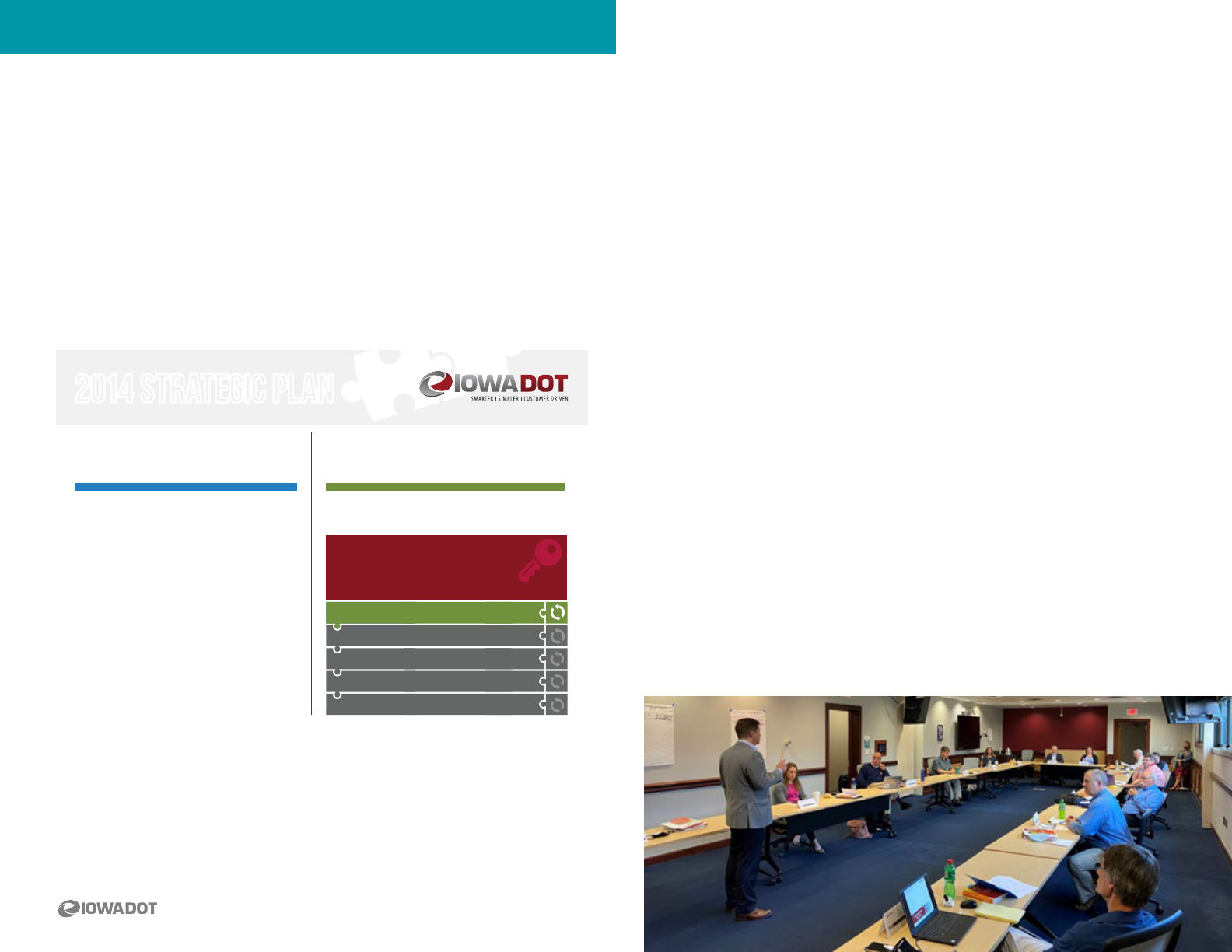
WHERE WE ARE | 6
| BUSINESS PLAN | JANUARY 2021
Previous Direction
In September 2020 the ELT embarked on a new strategic direction-setting initiative but had a stepping o point from previous eorts.
Early Business Plan development included a reimagining of DOT’s strategy, bringing it into sharper focus, and providing a framework
for more actionable implementation.
DOT’s Strategic Plans
Both the 2012 and 2014 strategic plans were short summaries of the
expected vision, mission, principles or values, and selected focus areas or
initiatives.
2014 STRATEGIC PLAN
HOW THE IOWA DOT
OPERATES DAY-TO-DAY
WHERE THE IOWA DOT
IS GOING
OUR MISSION
Getting you there safely, efciently,
and conveniently.
OUR CORE VALUES
Iowa DOT employees will demonstrate:
Safety – put safety rst in everything we do.
Respect – treat everyone with honor, dignity, and
courtesy.
Integrity – earn and demonstrate trust through
transparent and ethical actions.
Teamwork – work together through effective
communication, collaboration, and accountability.
Leadership – create vision, inspire others, and
set an innovative pace for our customers and the
transportation industry.
OUR VISION
Smarter, Simpler, Customer Driven
ONE IOWA DOT TEAM KEY INITIATIVES FOR CHANGE
Performance management
Data integration
Portfolio and project management
Organizational communication
Workforce and knowledge management
E
Initiatives will be worked on one at a time and led by a key
initiative team.
Team members will be made up of Iowa DOT staff members who have
a unique relationship to the initiative being worked on at that time.
www.iowadot.gov
Visit: www.iowadot.gov/strategicplan
TO LEARN MORE ABOUT THE STRATEGIC PL AN AND PROGRESS OF KEY INITIATIVES
MM726 09/03/2014
The stated desired culture was to be safe and engaged. Neither strategic
plan provided a timeline nor framework for implementation, so follow-
through has been challenging, as expected without the necessary
supporting systems for plan implementation.
This Business Plan is intended to remedy that by explicitly aligning the
DOT with the strategic direction in the State Long-Range Transportation
Plan (see the next page), reimagining our Core Values and Focus, and
providing an implementation approach and timeline divided into a regular
cadence.
Strategic and business planning at Iowa DOT also must align with the State
of Iowa direction. Importantly, the Governor’s 2021 priorities include the
following six initiatives:
• Ensuring Iowa’s Economic Prosperity
• Putting Students First
• Creating Universal Broadband Access for Iowans
• Ensuring Strong, Safe Communities
• Improving Access to Quality Health Care
• Reinvigorating the Iowa Agriculture Economy
Iowa continues to pursue modernizing state government, improving
workforce preparedness, and cultivating a nimble, customer-driven focus.
WHERE WE ARE
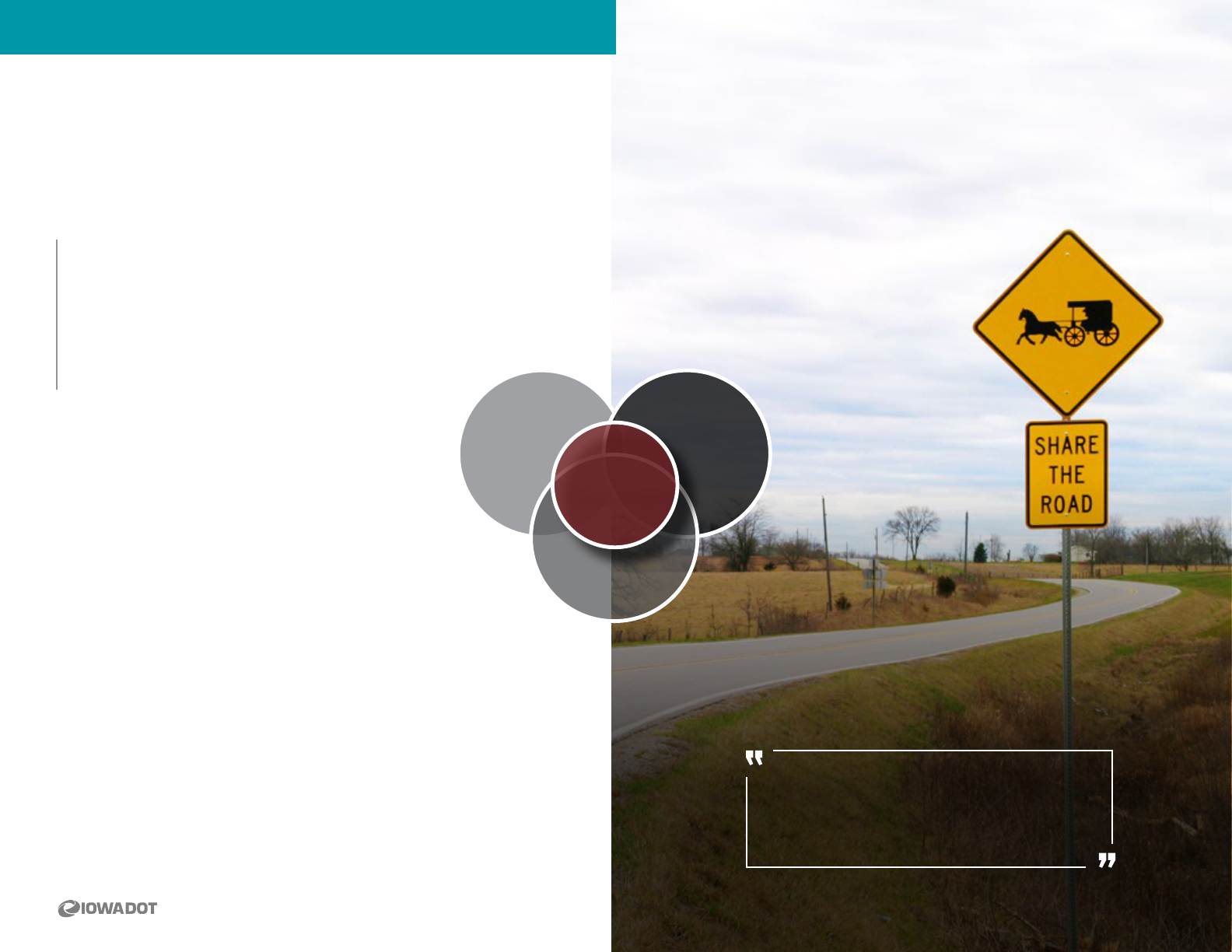
WHERE WE ARE | 7
| BUSINESS PLAN | JANUARY 2021
Strategic Alignment
This Business Plan plays an essential role connecting long-term strategy to short-term tactics. Long-range strategic direction for
transportation in Iowa is guided by the State Long-Range Transportation Plan (SLRTP). The current version is Iowa in Motion 2045, and
the next version is expected in 2022. The vision is:
A safe and ecient multimodal transportation system that
enables the social and economic wellbeing of all Iowans, provides
enhanced access and mobility for people and freight, and
accommodates the unique needs of urban and rural areas in an
environmentally conscious manner.
The SLRTP strategies are aligned with four principal
investment areas:
• Stewardship through maintaining a state of good
repair
• Modication through right-sizing the system
• Optimization through improving operational
eciency and resiliency
• Transformation through increasing mobility and
travel choices
The Business Plan helps the Department organize to achieve the SLRTP,
including redening DOT’s values, vision, and mission into new terms of
Core Values, Core Focus, and 10-Year Target. The Plan guides nearer-term
implementation by clearly dening the 10-Year Target, Priority Goals, and
5-Year Picture. These are outlined in the following sections.
Continuing its bridge between the strategic and tactical, the Business Plan
implementation includes annual denition of the highest priority 1-Year
Objectives that move DOT toward its preferred future. The tactics and
actions are further specied in the 90-Day Rocks, reestablished quarterly,
that each Division and most Bureaus will own.
WHERE WE ARE
Leadership is the capacity to translate vision
into reality.
Warren Bennis
Stewardship
OptimizationModication
Transformation

WHERE WE ARE | 8
| BUSINESS PLAN | JANUARY 2021
WHERE
WE’RE
GOING
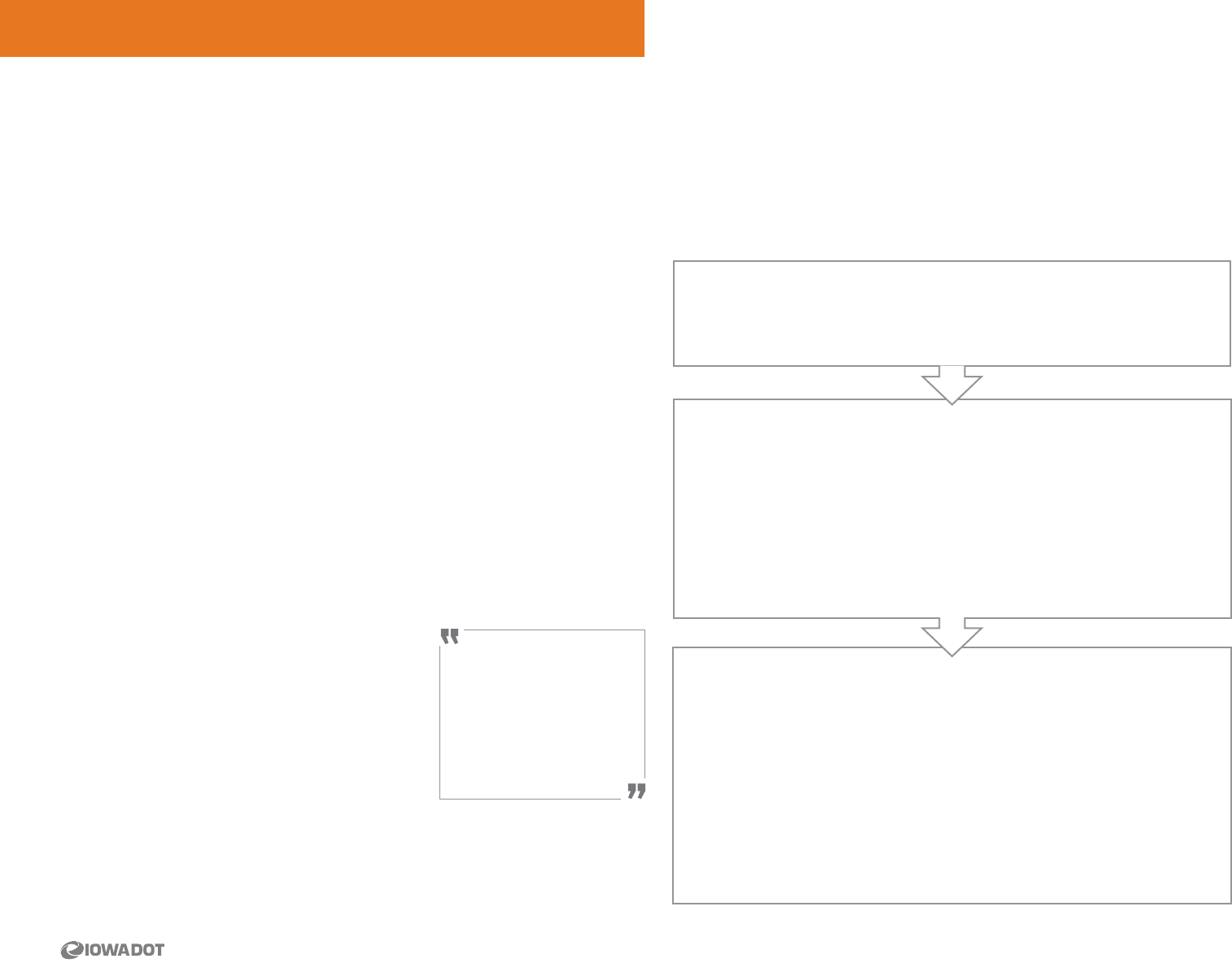
WHERE WE’RE GOING | 9
| BUSINESS PLAN | JANUARY 2021
Values & Focus
The following values and descriptive statements form the nucleus of the Business Plan. The DOT redened Core Values, shown on the
left, which together with the Core Focus and 10-Year Target form the redened vision. The Priority Goals and Objectives that follow
are specically designed to align with these Core items.
Iowa DOT’s Core Values
` Safety First
The safety, security, and wellbeing of sta, travelers, and customers is
of utmost importance. We are committed to continuous feedback and
learning to be safer, proactive, more resilient, and highly prepared.
` People Matter
We are committed to diversity, respect, listening well, and engaging
all in meaningful ways. Our culture emphasizes civility, continuous
improvement, innovation, and reasonable risk taking.
` Customer Focused
We are committed to consistently providing high quality service for our
external and internal customers. We promote a positive customer focus by
understanding customer needs and empowering sta to be responsive.
` Servant Leadership
We are intentional to never be complacent and
to always follow through with serving the public
and each other. Leading by serving embraces a
positive commitment to personal growth, being
helpful, and aligning our eorts.
` Integrity Without Exception
We foster a culture of respect, honesty, and
commitment. Transparency, accountability, and ethical behavior undergird
all we do as stewards of Iowa’s transportation resources.
I learned to always
take on things I’d never
done before. Growth
and comfort do not
coexist.
Virginia Rometty
10-Year Target
The preferred future of the DOT looks 10 years out, beyond the Plan
but not so far as the SLRTP. This unifying aspirational statement is
called the 10-Year Target:
Safest - Smartest - Made to Last
Iowa has the most customer-focused, safe, reliable, and ecient
transportation system and services in the nation through agility and
innovation.
Iowa DOT’s Core Focus
Making Lives Better
Through Transportation
The reason for Iowa DOT existing is to make lives better through
transportation. Serving the people and businesses of Iowa, the DOT
has the unique niche as Stewards of Iowa’s Transportation System.
WHERE WE’RE GOING
The State of Iowa Core Purpose
Enhancing the Quality of Life for Iowans
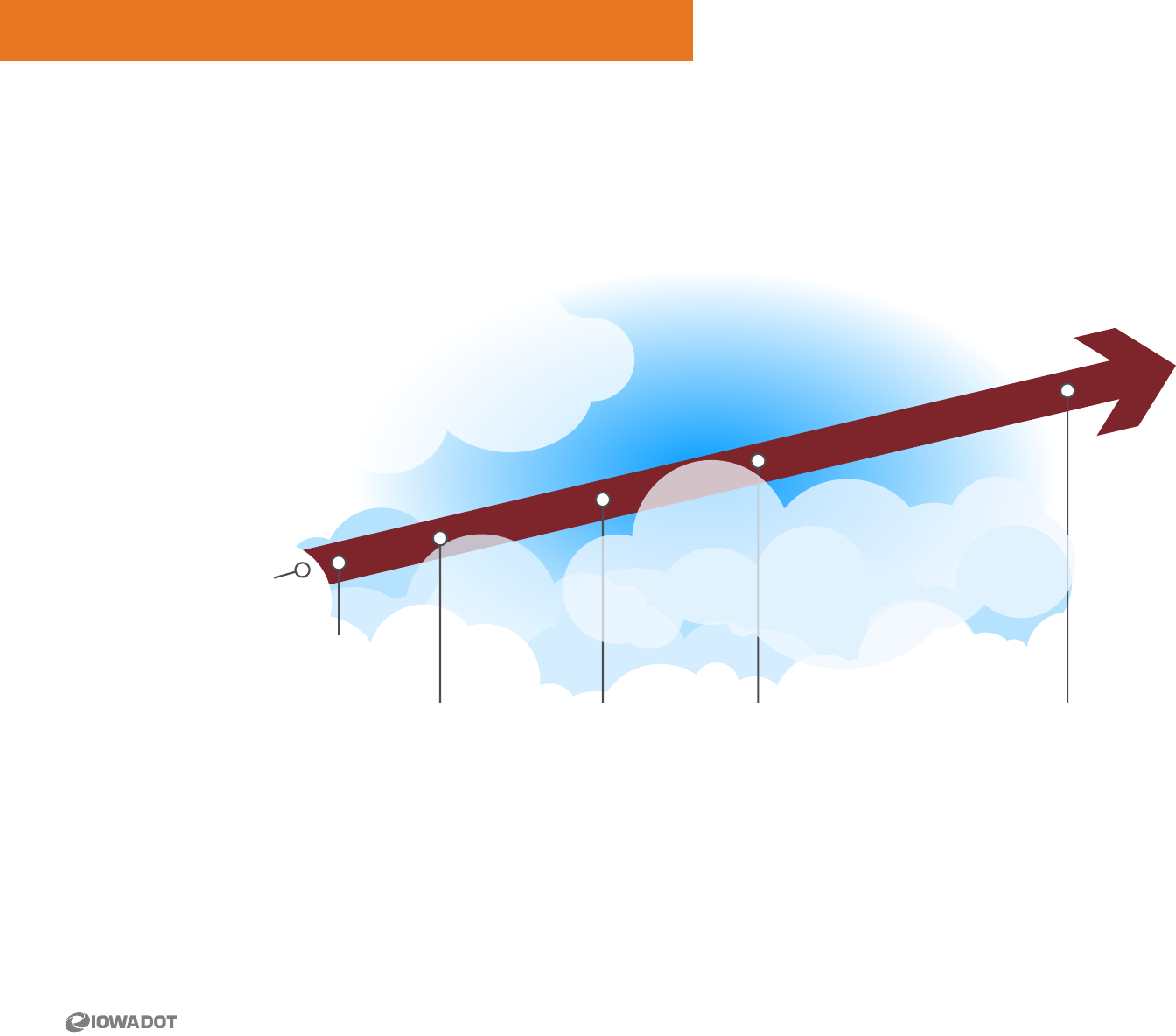
WHERE WE’RE GOING | 10
| BUSINESS PLAN | JANUARY 2021
WHERE WE’RE GOING
Positioning any organization to achieve its preferred future involves continual change and improvement. The Iowa DOT is a large
and complex organization with substantial responsibilities – and it has never had a business plan before – so altering course will take
time, commitment, and a specic and implementable plan. The Business Plan implements the SLRTP and organizes the DOT with
Core Values, Core Focus, and a 10-Year Target that move us closer to that longer range vision. Following that direction, the ELT has
dened ve Priority Goals.
The 5-Year Priority Goals are revisited every other year with the Business
Plan updates. The SLRTP is the strategic direction for transportation in Iowa,
and this Business Plan further enables implementation of other specic
plans the DOT is responsible for such as the Strategic Highway Safety Plan
and State Freight Plan.
The last part of this section on Where We’re Going contains the 1-Year
Objectives. These 1-Year Objectives are the bridge to How We Get There,
which includes the near-term implementation tools and processes that will
be used to execute this plan.
Today
90-Day Rocks
completed &
renewed quarterly
1-Yr Objectives
rened & prioritized
annually
updated & armed bi-annually
with Values, Purpose, & Goals
5-Yr Picture 10-Yr Target 25-Yr SLRTP
redeveloped every 5 years
Continual Change & Improvement Toward Preferred Future
Complementary strategic,
programmatic, modal, and
service layer plans
Innovation, Pilots, and Scaling for Impact
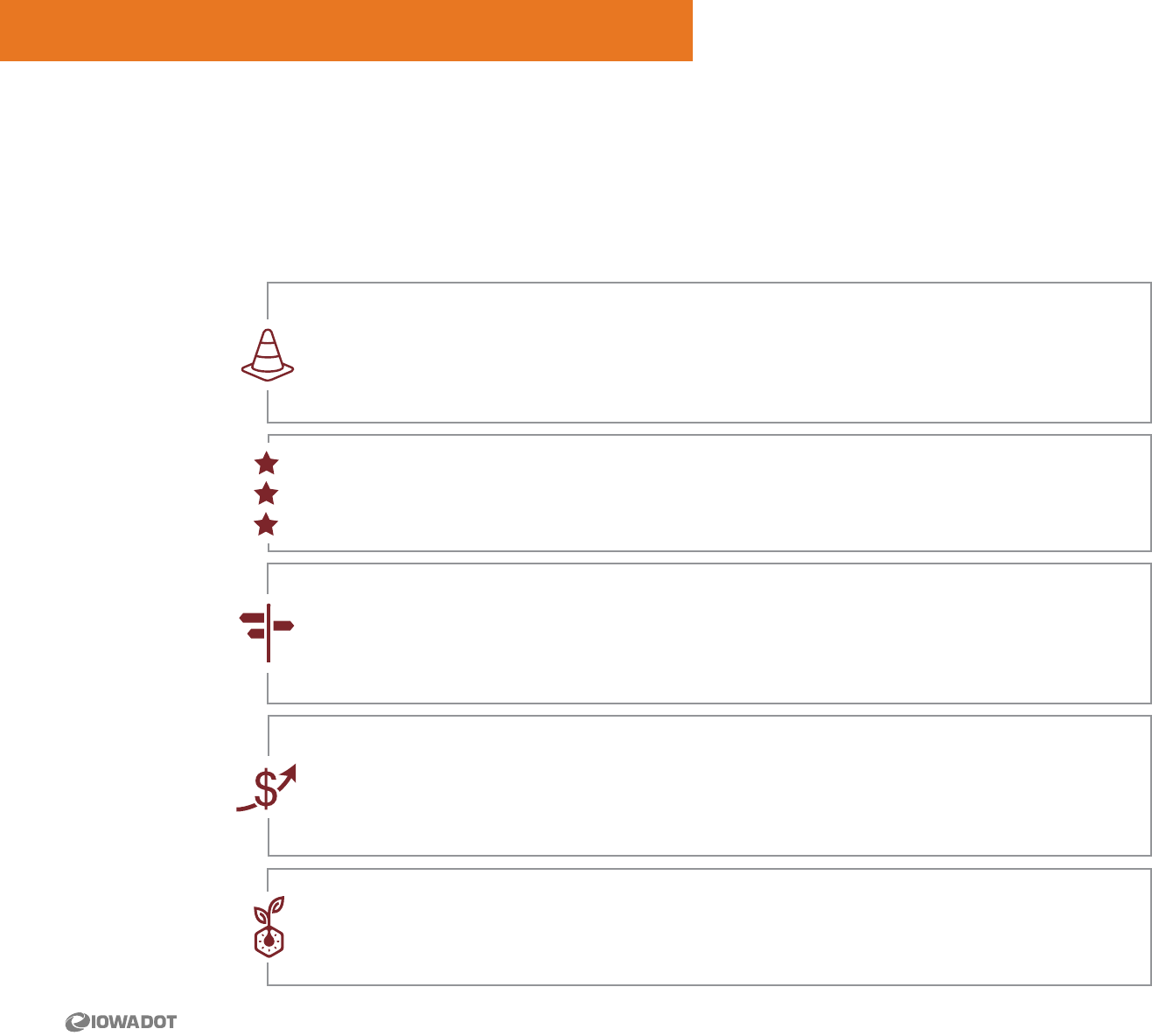
WHERE WE’RE GOING | 11
| BUSINESS PLAN | JANUARY 2021
5-Year Priority Goals
From a wide range of possibilities, the ELT dened and prioritized ve Priority Goals for the next ve years. The intent of the Business
Plan is to achieve each Priority Goal. These are the building blocks for Iowa DOT’s preferred future and form an essential connection
between the broader direction in the previous section and the increasingly detailed 5-Year Picture, 1-Year Objectives, and 90-Day
Rocks (the highest priority actions for divisions and bureaus) that drive change and improvement.
WHERE WE’RE GOING
Goal 1.
Improve Transportation System Safety & Performance
Outcomes include: zero fatalities in work zones, total trac fatalities signicantly reduced, increased
eciency, reliability, resiliency, and condition of our transportation system
Goal 2.
Improve Customer Service
Outcomes include: greater levels of customer satisfaction across all programs and services
Goal 3.
Advance Workforce for Future Challenges & Opportunities
Outcomes include: engaged and empowered employees, increased diversity, equity, and inclusion,
and steady reductions in turnover rate (non-retirement)
Goal 4.
Secure Stable & Sustainable Funding
Outcomes include: implemented funding strategies, ensured diversied funding mechanisms, and
reduced technical debt (e.g., legacy systems)
Goal 5.
Grow Innovation
Outcomes include: adopted smart technologies, culture of innovation, and modernized systems

WHERE WE’RE GOING | 12
| BUSINESS PLAN | JANUARY 2021
5-Year Picture
Under each of the ve Priority Goals are elements of the 5-Year Picture of the Iowa DOT with the Business Plan horizon. This outlines
the direction for focused eort over the next ve years. The ELT has further prioritized these into 1-Year Objectives for the rst year
and will repeat that prioritization every year. The prioritized objectives for the coming year include more detail as well as measurables.
The 5-Year Picture adds clarity of
purpose to the Priority Goals. This
Picture of the DOT at the end of
the Business Plan horizon is both
compelling and achievable. These
are not actions, but outcomes that
will be brought to life through 1-Year
Objectives and 90-Day Rocks.
Goal 1. Improve Transportation System Safety & Performance
In ve years transportation throughout Iowa will be safer and performing
better. Work zones will be free from fatalities, total fatalities will be
signicantly reduced, and the system will be more resilient, reliable, and
ecient.
Key outcomes include:
• Reduced fatalities and serious injuries
• Improved system reliability, reduced non-recurring congestion
• Improved system preservation and maintenance
• Improved system resilience
• Right-sized system
• Legislative barriers addressed
• New technology and innovation improving safety and performance
• More comprehensive traveler information
• Eective corridor management
• Improved freight operations
• Improved quality, reduced costs of change orders
Goal 2. Improve Customer Service
Our internal and external customer service will be improved through the
execution of this Business Plan. We will have greater levels of employee
engagement and customer satisfaction across all programs and services.
Key outcomes include:
• Customer needs are better understood and better met
• Improved internal service and collaboration across the “white space” of
the organizational chart
• Increased customer convenience and service options
• Enhanced customer information and engagement
• Internal / external customer service priorities are better understood and
improved
Goal 3. Advance Workforce for Future Challenges & Opportunities
Our engaged and empowered employees will be well-equipped to meet
both the challenges and opportunities of the future. Our workforce will
continue advancing and adapting, be more diverse, and we will have
reduced non-retirement turnover rates.
Key outcomes include:
• Better engaged and empowered workforce
• Increased employee retention
• Implemented human resource (HR) innovations for career paths,
vacancies, and training
• The right people in the right seats
WHERE WE’RE GOING
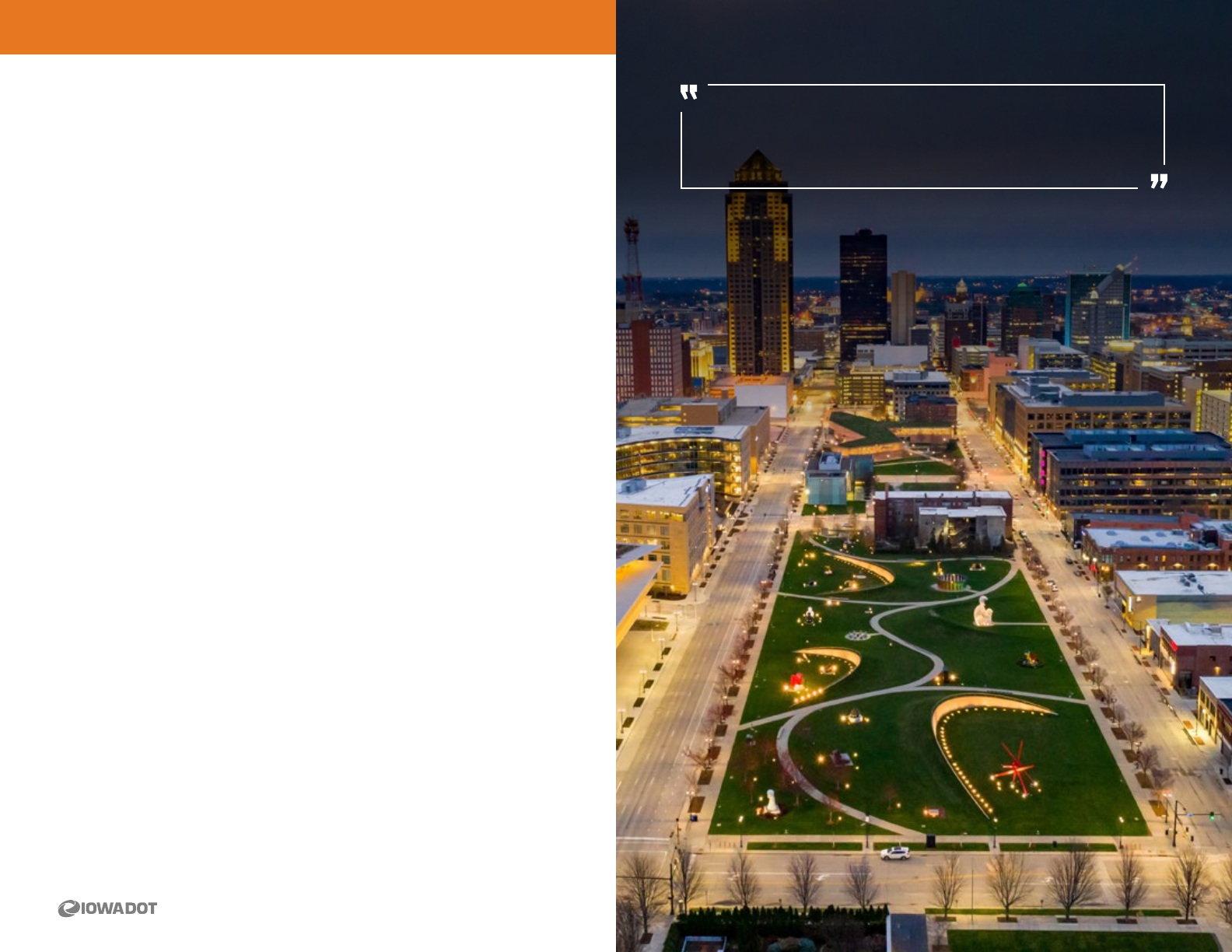
WHERE WE’RE GOING | 13
| BUSINESS PLAN | JANUARY 2021
WHERE WE’RE GOING
• Increased diversity, equity, and inclusion
• Improved capacity building and coaching opportunities for employees
Goal 4. Secure Stable & Sustainable Funding
As stewards of Iowa’s transportation system, in ve years we will have
addressed resource needs and identied new, stable, and sustainable
funding to ensure our transportation system is well-maintained.
Key outcomes include:
• Established reliable, stable, and sustainable funding strategies and
sources
• Funding needs addressed through required legislative study
• Reduced technical debt and the nancial burden imposed by legacy
information technology (IT) systems
• Diversied and new funding mechanisms in place
• Additional federal funding available for Iowa’s transportation system
Goal 5. Grow Innovation
Innovation is an integral part of improving an organization, and we will
have nurtured a stronger culture of innovation, cultivated improved
processes, and adopted modern systems and technologies.
Key outcomes include:
• Adopted and deployed technology solutions
• Integrated business performance throughout the Department
• Implemented new approaches to growing innovation
• Supported programs and initiatives to advance new and emerging
technologies
• Improved prioritization process for IT investment portfolio
• Modernized business systems
Innovation is real work, and it can and should be managed
like any other corporate function.
Peter Drucker

WHERE WE’RE GOING | 14
| BUSINESS PLAN | JANUARY 2021
1-Year Objectives
The last step of Where We’re Going is setting the Objectives for each calendar year. These are interwoven with ongoing business and
operations needs but must be understood to be working ON the business not just working IN the business. As important as 1-Year
Objectives are in the short term, the 5-Year Picture and Priority Goals are equally important over the ve-year planning horizon.
2021 Objectives
The ELT has established the following objectives for 2021, the highest priority
items to accomplish in year one of the ve-year Business Plan horizon. Here
is what we are putting extra focus on in 2021, which is essential for achieving
the 5-Year Picture and moving toward the 10-Year Target.
Objective 1. Reduce Fatalities to Under 300
• Averaged 342 per year in 2015-2019; it was last under 300 in 1925
• Collaborate with the Iowa Department of Public Safety and the Fatalities
Reduction Task Force
• Zero employee fatalities or serious injuries
• Enhance work zone safety for employees and travelers
Objective 2. Update Organizational Structure & HR Business Practices
to Align with Organizational Strategies
• Identify core service areas, conrm the Right Seats
• Update structure – DOT-wide and within Divisions – to best support core
services and achieve priorities
• Pursue HR innovations, e.g., horizontal career paths, process for vacant
positions, and others
• Prioritize and advance Diversity & Inclusion Task Force recommendations
• Increase agency Gallup Engagement to at least 30% overall percentile
ranking
Objective 3. Implement New Customer Feedback Programs
• Create programs (e.g., initiatives, processes, systems, and other
mechanisms) to garner feedback representing Iowans
• Develop a customer satisfaction index and report
• Prioritize customer needs
• Implement improved information and service options in response to
feedback from customers
Objective 4. Reimagine How We Invest in Technology
• Overhaul information processing (IP) planning and revamp IT
prioritization and decision-making processes
• Identify and prioritize 5-year technology needs by Divisions
• Develop a 5-year DOT (internal) technology strategy
• Modernize or retire outdated systems
Objective 5. Implement Business Measures that Move Us Forward
• Develop internal organizational performance frameworks
• Identify, eva
luate, and dene priority measures that drive business decisions
• Implement ELT Scorecard (the 5-15 most important numbers), updated
biweekly, both DOT-wide and for Divisions
Each year hereafter, these objectives will be assessed and new or rened objectives will be set for the next year that drive the DOT toward the 5-Year Picture
and Priority Goals. The Business Plan is updated every two years, so the next iteration of 1-Year Objectives for 2022 will be formulated in summer 2021. These
should be drawn from the 5-Year Picture outlined above, but circumstances change, and regardless the new 1-Year Objectives must be the highest priority
three to seven items to accomplish that year.
WHERE WE’RE GOING
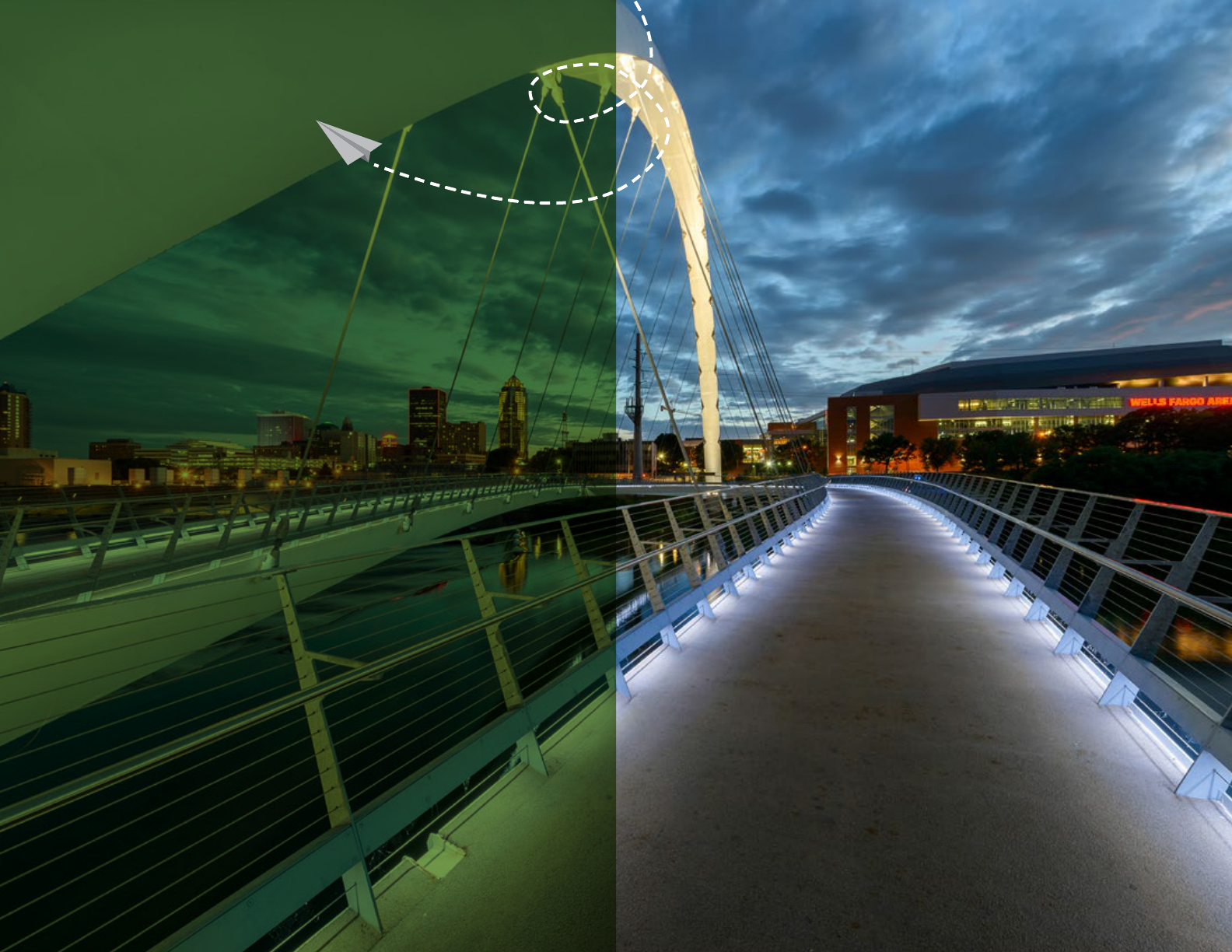
WHERE WE’RE GOING | 15
| BUSINESS PLAN | JANUARY 2021
HOW WE GET
THERE
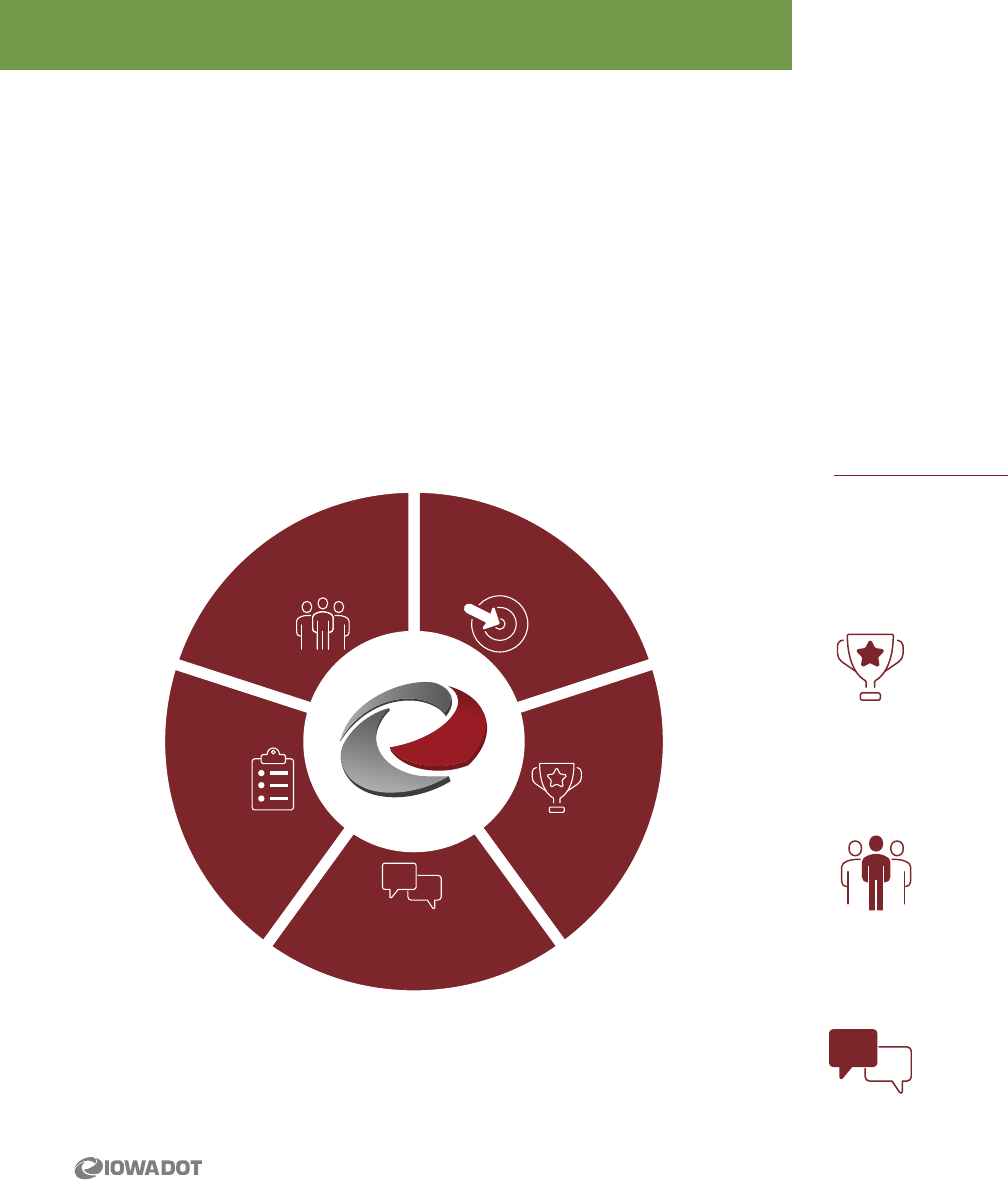
HOW WE GET THERE | 16
| BUSINESS PLAN | JANUARY 2021
HOW WE GET THERE
Implementation Approach
Planning has great value in nearly every facet of the lives of individuals and organizations. The value of any plan can, however, only
be realized with intentional, consistent, and systematic implementation. The Iowa DOT ve-year Business Plan will achieve the Priority
Goals following a comprehensive and predictable implementation approach.
Throughout implementation, the ELT will ensure that full attention is given
to the connections between the Priority Goals, 5-Year Picture, the crucial
1-Year Objectives, and the Rocks established for them. This section outlines
the approach to implementation and is followed by a summary of the
various tools being used to carry out and reinforce that implementation.
P
E
O
P
L
E
•
R
o
c
k
s
•
M
e
e
t
i
n
g
s
•
R
i
g
h
t
P
e
o
p
l
e
•
R
i
g
h
t
S
e
a
t
s
I
S
S
U
E
S
•
I
s
s
u
e
s
L
i
s
t
•
I
D
S
T
R
A
C
T
I
O
N
P
E
R
F
O
R
M
A
N
C
E
•
D
a
t
a
•
P
r
o
c
e
s
s
V
I
S
I
O
N
•
8
Q
u
e
s
t
i
o
n
s
•
S
h
a
r
e
d
B
y
A
l
l
•
R
o
c
k
s
•
M
e
e
t
i
n
g
s
Primary Implementation Areas of Focus
In developing the Business Plan, the ELT considered various aspects of
successful plan implementation. Among them, several were identied as
being the most important. Each is listed and briey described below, as
related to the Entrepreneurial Operating System (EOS). The EOS framework
(eosworldwide.com) is leveraged and adapted throughout this Business
Plan, especially for its eective implementation tools. Please refer to the
appendix for a glossary of key EOS terms used throughout the execution
of the Business Plan.
Linking Business Plan to Budget and Resource Allocation
Various resources are necessary to accomplish the ve Business
Plan Priority Goals, such as people, money, and partnerships
with stakeholders. Our Business Plan will be used as the primary
reference point in establishing and updating budget priorities
and other resource decision making.
Executing a Communication Strategy Supporting Business Plan
Implementation
Every Iowa DOT employee has a role to play in the successful
implementation of the Business Plan. To that end a
communications strategy is carried out that raises awareness,
helps everyone know where they t, addresses questions, and
provides open forums for idea sharing.
Holding Employee Business Plan Meetings
In the rst year of Business Plan implementation, meetings will
be held to eectively engage employees in the implementation
process. The focus will be to ensure that all are aware of the plan
and its importance to the Department and our customers.
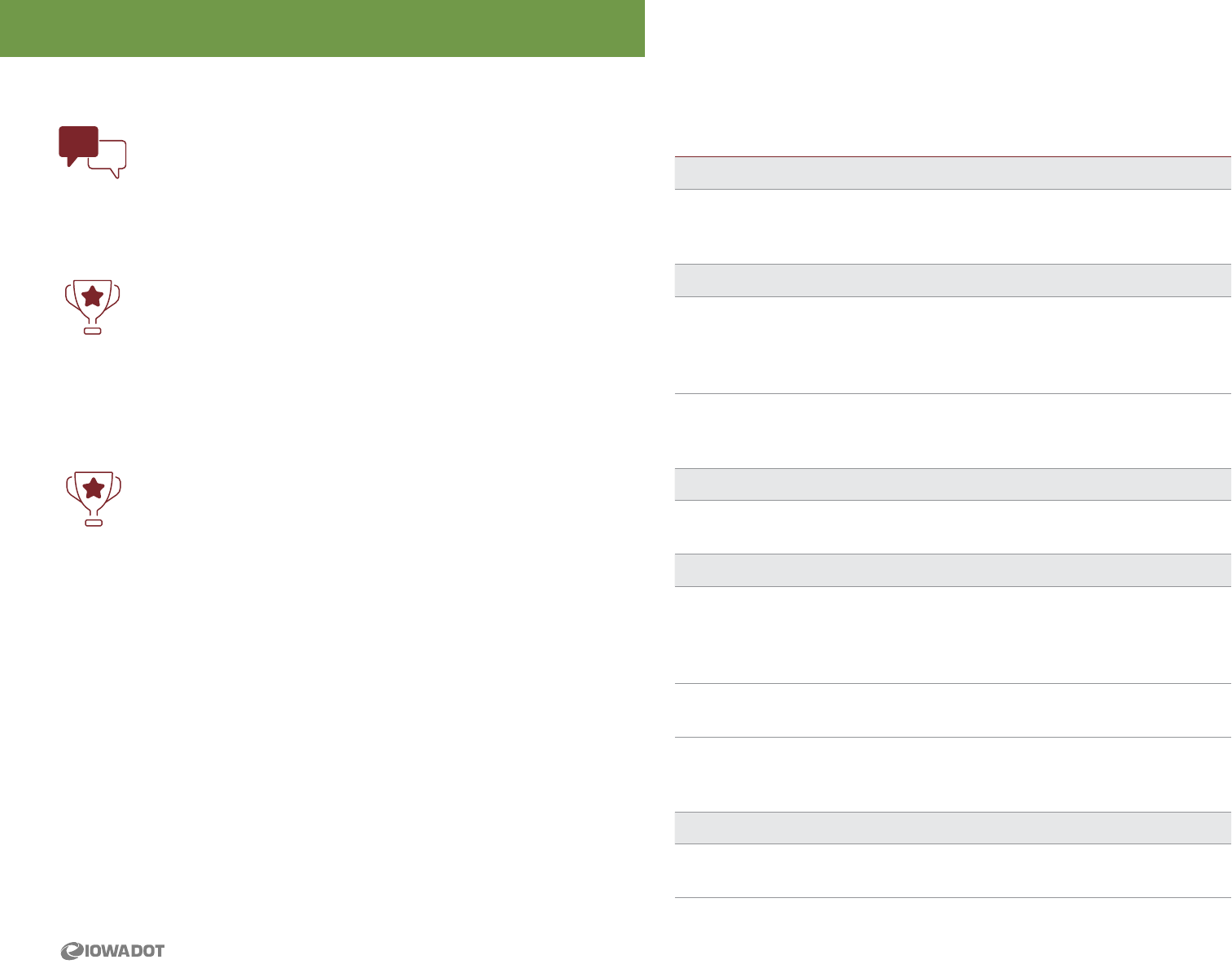
HOW WE GET THERE | 17
| BUSINESS PLAN | JANUARY 2021
Dening Lead and Support Roles for Business Plan Objectives
Other keys to successful Business Plan implementation are
accountability and teamwork. By identifying lead and support
roles for the Business Plan objectives, each is reinforced
Department wide.
Linking Business Plan to Unit and Individual Goal Setting and
Performance Reviews
Plans too often fail to connect an organization’s vision with goal
setting in business units and for individuals. We will follow a
positive and impactful approach that links Business Plan Core
Values and Priority Goals with the annual Objectives of each
unit and for individual goal setting and reviews. All Bureaus will
act on 90-Day Rocks to achieve 1-Year Objectives and support
the DOT’s vision.
Using an Action Plan Approach with EOS Tools
Finally, action plans are typically the most used approach to
ensure that a plan’s implementation is progressing and being
regularly reviewed. The action plan philosophy will be followed
by leveraging the various tools that bolster implementation.
Those are summarized in the following table.
Implementation Tools
The Business Plan proceeds with rollout and communication, managing
change, and developing alignment throughout the DOT. The following
set of implementation tools bring value and focus from day one, and as
small, early gains are accomplished, traction sets in and scaling for greater
impact follows. More information on these tools and how to use them is
available separately from this Business Plan.
IMPLEMENTATION TOOLS
Tool Purpose/Value
VISION
Vision / Traction
Organizer (V/TO)
2-page summary, answers eight questions from
Core Values and Focus to Priority Goals to initial 90-
Day Rocks
PEOPLE
Accountability
Chart
An aid to organizational restructuring, blank slate
exercise to dene structure needed to deliver
essential processes , and establish clear lines of
accountability
Performance
Evaluations
Supervisor and sta reviews will incorporate
engagement, empowerment, and self-evaluation of
alignment with Core Values
ISSUES
Issues Solving
Track
Drop issues down, prioritize, then Identify, Discuss,
Solve (IDS); part of every Level 10 meeting
TRACTION
Meeting Pulse Annually, rearm and update Core items and
Goals, and prioritize objectives for the year ahead;
quarterly, review V/TO and prior Rocks, set new
Rocks, resolve issues; and biweekly, L10 meetings
Level 10 (L10)
Meetings
Structured, high-value, 90-minute ELT meetings that
review Rocks and Scorecard, and resolve issues
90-Day Rocks Prioritize 3-7 most important items to accomplish
in next 90 days, every Rock has an owner, and every
Division and most Bureaus have Rocks
PERFORMANCE
Scorecard Top level, 5-15 biweekly priority numbers for Iowa
DOT; evidence-based leadership
HOW WE GET THERE
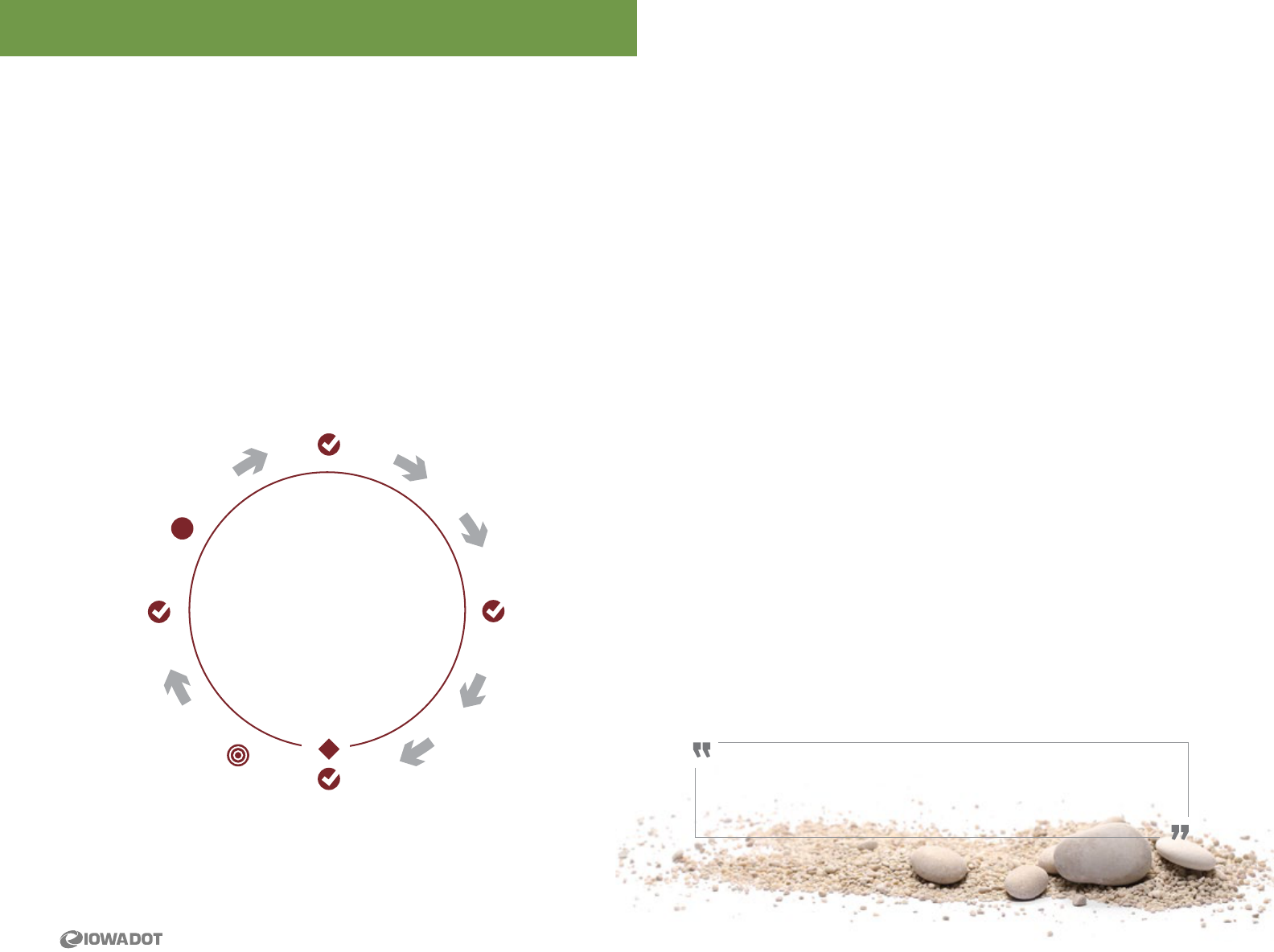
HOW WE GET THERE | 18
| BUSINESS PLAN | JANUARY 2021
Implementation
The implementation areas of focus weave with the
implementation tools in a way that clearly denes an action
plan. This section intentionally does not lay out multi-year
steps, but the iterative process that repeats with each cycle:
• Every two calendar years – Business Plan updated
• Every calendar year – 1-Year Objectives rened and reprioritized
• Every quarter – 90-Day Rocks completed and renewed
• Recurring L10 meetings
* Every other year the Business Plan update includes Objectives renement
J
A
N
F
E
B
M
A
R
A
P
R
M
A
Y
J
U
N
J
U
L
A
U
G
S
E
P
O
C
T
N
O
V
D
E
C
Rocks
renewed
Rocks
renewed
Rocks
renewed
Rocks
renewed
Fiscal year
budgeting
$
Objectives
rened*
F
Y
e
n
d
/
b
e
g
i
n
This cycle aligns with the Meeting Pulse, and in every meeting, attendees
are expected to voice their opinion, ask questions of things not
understood, and collaborate on ecient L10 Meetings and solving issues
with IDS. Revisiting the primary implementation areas of focus introduced
in the last section we reinforce how each implementation tool supports
longer term improvement:
• The Business Plan and V/TO are linked to budget and resource allocation
as they are updated biennially to stay in sync with two-year budgets,
and the 1-Year Objectives are updated and reprioritized annually with
resource constraints among the evaluation criteria. Throughout the
cycles, resource constraints are an expected and recurring issue to be
rectied as Objectives and Rocks are undertaken and with the Issues
Solving Track in recurring meetings. The 10-Year Target is aspirational,
but the 1-Year Objectives and 90-Day Rocks are carefully dened to be
achievable with existing resources.
• Dening and executing a communication plan is essential for supporting
implementation of the Business Plan. The audience is both internal
and external customers. Communications will be planned in the rst
quarter of calendar 2021, leveraging change management techniques.
Recognizing both the foundational challenges and the inspirations, the
plan will include Business Plan roll-out, supporting outreach tools (e.g.,
stories, blogs, videos), and scheduled points in 2021 to communicate
progress.
• It is essential that all leadership and management know this Business
Plan and clearly communicate the critical importance of aligning
workforce activity with DOT’s direction contained here, from Core Focus
down to 1-Year Objectives and 90-Day Rocks. As the Business Plan is
communicated internally, management are expected to build o the
Plan and hold in mind each of the ve Core Values and ve Priority Goals.
HOW WE GET THERE
If the big rocks don’t go in rst, they aren’t going to t in later.
Stephen Covey
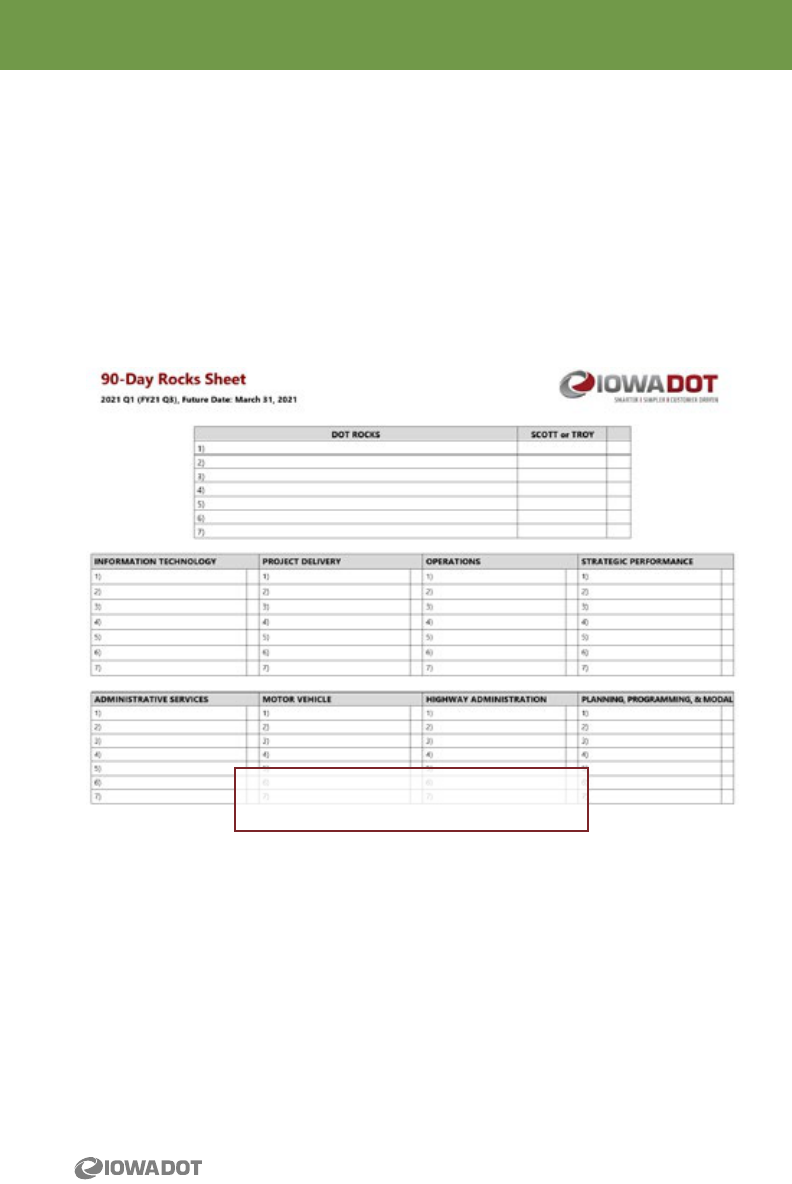
HOW WE GET THERE | 19
| BUSINESS PLAN | JANUARY 2021
• Lead and support roles are dened beginning with the ELT, updated
structure, and individual ownership of each Rock. These Rocks are
specic, not vague, and each lead owner is likely to have support
helping them with any given Rock. In turn, individuals down the
organization chart will be taking on their own Rocks each quarter. Not
all business units are required to hold L10s, but all divisions and most
bureaus will have 90-Day Rocks. Throughout a given quarter, updates are
made at recurring L10 meetings, and no new priorities should be added
until the quarterly renewal.
Rocks sheets for ELT and Divisions
are maintained separately
• The Business Plan also propagates throughout the DOT via unit and
individual goal setting and performance reviews. Reviews will adapt
to include the ve Core Values. The ELT will have a top level Scorecard
providing evidence of progress toward goals, and in time multiple
business units will be minding their own Scorecards biweekly.
• This actionable approach leverages EOS tools to provide the clear and
foundational process to follow through Business Plan execution.
What Happens in 2021
Both the executive summary and V/TO provide two-page summaries
of essential elements of this plan. The V/TO is shown at the front of the
appendix and available as a separate two-page document. These two
items will be used as quick reference throughout 2021.
The 1-Year Objectives are set for 2021, each tied to one or more Priority
Goal and Core Value:
1. Reduce Fatalities to Under 300
2. Update Organizational Structure & HR Business Practices to Align with
Organizational Strategies
3. Implement New Customer Feedback Programs
4. Reimagine How We Invest in Technology
5. Implement Business Measures that Move Us Forward
From the 5-Year Picture and these 1-Year Objectives, the ELT has
formulated their Quarterly Rocks for 2021 Q1 (FY21 Q3). Examples of top-
level Rocks are included on the V/TO. The ELT and each Division maintain
a working Rocks sheet on DOT’s SharePoint, to be referred to in all L10
meetings, and renewed at the end of each quarter.
» For instance, early eorts in 2021 may include developing a new process
for vacancies, implementing a scorecard, lling the CIO position and
completing other Rocks, each owned by a member of the ELT.
» A key rst quarter Rock is setting the plan for roll-out and
communication of this Business Plan.
This Business Plan contains new
ways of doing business, and change won’t occur without sustained focus.
HOW WE GET THERE
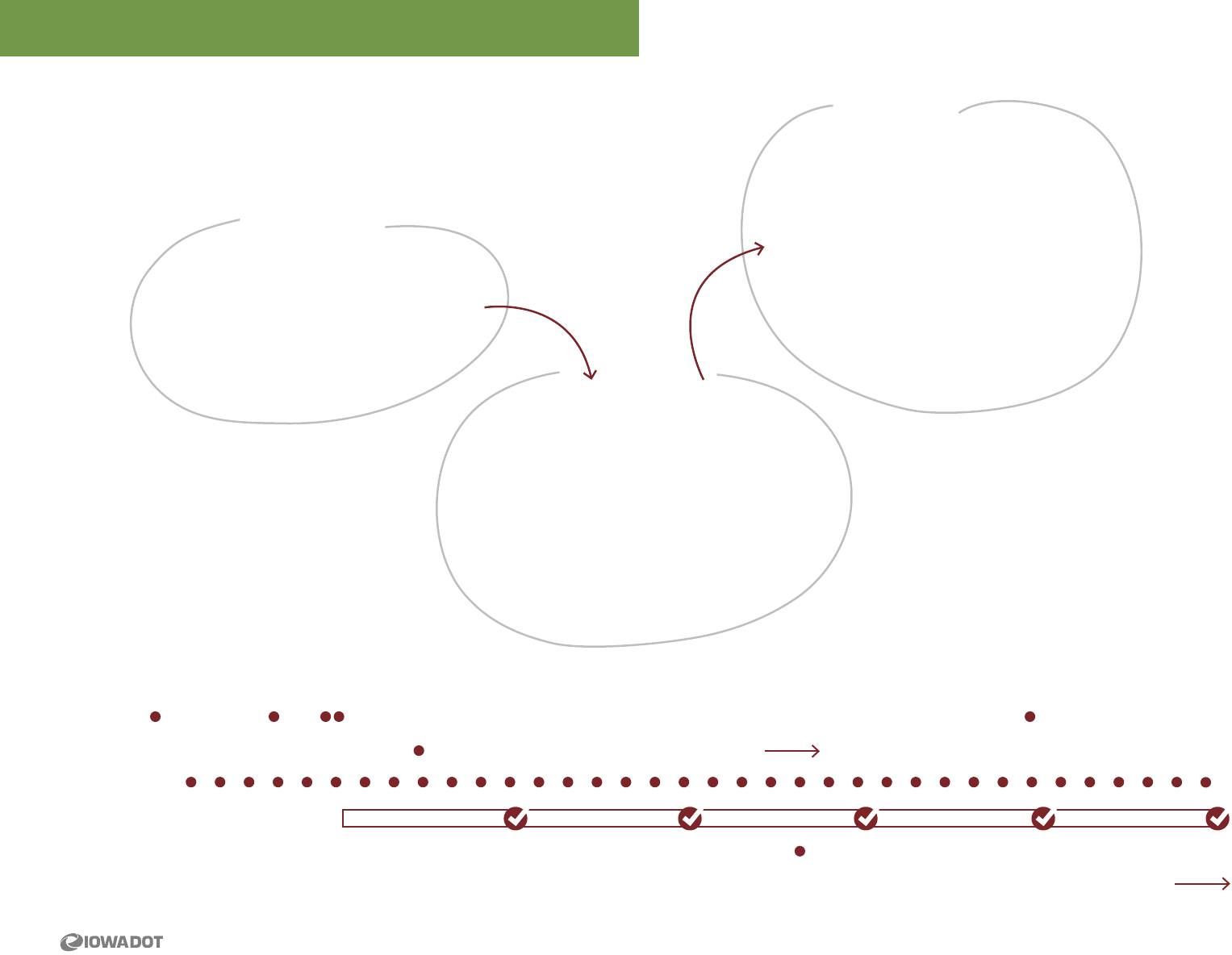
HOW WE GET THERE | 20
| BUSINESS PLAN | JANUARY 2021
HOW WE GET THERE
The ELT has already adopted the L10 Meeting format, including the Issues
Solving Track, with good success. The Issues Solving Track depends on
dropping issues down to an issues list as they come up, and not chasing them
down a rabbit hole. L10 participants later quickly pick the highest priority
issues and Identify, Discuss, Solve (IDS) them, permanently.
• The obvious is rarely the problem
• Dig down
• Don’t move forward until you
clearly identify the root issue
• Stay laser focused
• No tangents
Identify
• Open, honest, share thoughts
ideas, concerns, solutions
• Discuss, debate, get it all out on the
table, but only say it once
• If politicking or redundant, it’s time
for the solution
• Keep the greater good in mind;
a solution is likely simple, but
sometimes very hard
Discuss
• It’s more important that you
decide than it is what you decide ...
so decide!
• Restate until you hear “the sweet
sound of agreement”
• Once everyone can live with the
decision (not necessarily agrees),
the action step(s) must be
owned by someone and
put on the To-Do List
Solve
Sep Oct Nov Dec Jan Feb Mar Apr May Jun Jul Aug Sep Oct Nov Dec Jan Feb Mar
2020 2021 2022
Workshops
Business Plan Developed and Released
Biweekly L10s
Quarterly Rocks Completed & Renewed
1-Year Objectives Rened & Prioritized
Business Plan Updated at the end of 2022
Business Plan Roll-Out & Communications
2021 Q1 2021 Q2 2021 Q3 2021 Q4 2022 Q1

HOW WE GET THERE | 21
| BUSINESS PLAN | JANUARY 2021
HOW WE GET THERE
The Meeting Pulse is key for generating the cadence for Traction with this
Business Plan. The Pulse follows the cycle outlined above, and the timeline
graphic that follows depicts this cadence for 2021.
In summer 2021, the ELT will take the 5-Year Picture and the current 1-Year
Objectives, and they will create a new set of 1-Year Objectives for 2022,
followed by 2022 Q1 Rocks.
Calendar year 2022 follows the same cycle as 2021, but at the end of 2022
the ELT will update the Business Plan. The Core elements of the V/TO are
up for renewal or renement, as is the 10-Year Target. Because the DOT will
be two years into the 5-Year Picture, a careful review of the 5-Year picture is
essential.
With the updated Business Plan, the 1-Year Objectives are set once again,
this time for 2023, followed by 2023 Q1 Rocks!
If you’re running a race, and you’re looking at the lane to your right
or your left, you’re gonna trip instead of... focusing forward
Dylan Lauren
Thank You
Scott Marler, Iowa DOT Director
Troy Jerman, Chief Operating Ocer
Mitch Dillavou, Chief Engineer, Highway Administration
Stu Anderson, Director, Planning, Programming, and Modal Division
Bill George, Interim Director, Information Technology Division
Melissa Gillett, Director, Motor Vehicle Division
Dave Lorenzen, Director, Operations Division
Charlie Purcell, Director, Project Delivery Division
John Selmer, Director, Strategic Performance Division
Lee Wilkinson, Director, Administrative Services Division
Andrea Henry, Director, Strategic Communications
Mikel Derby, Federal Relations Liaison
Susan Fenton, State Legislative Liaison
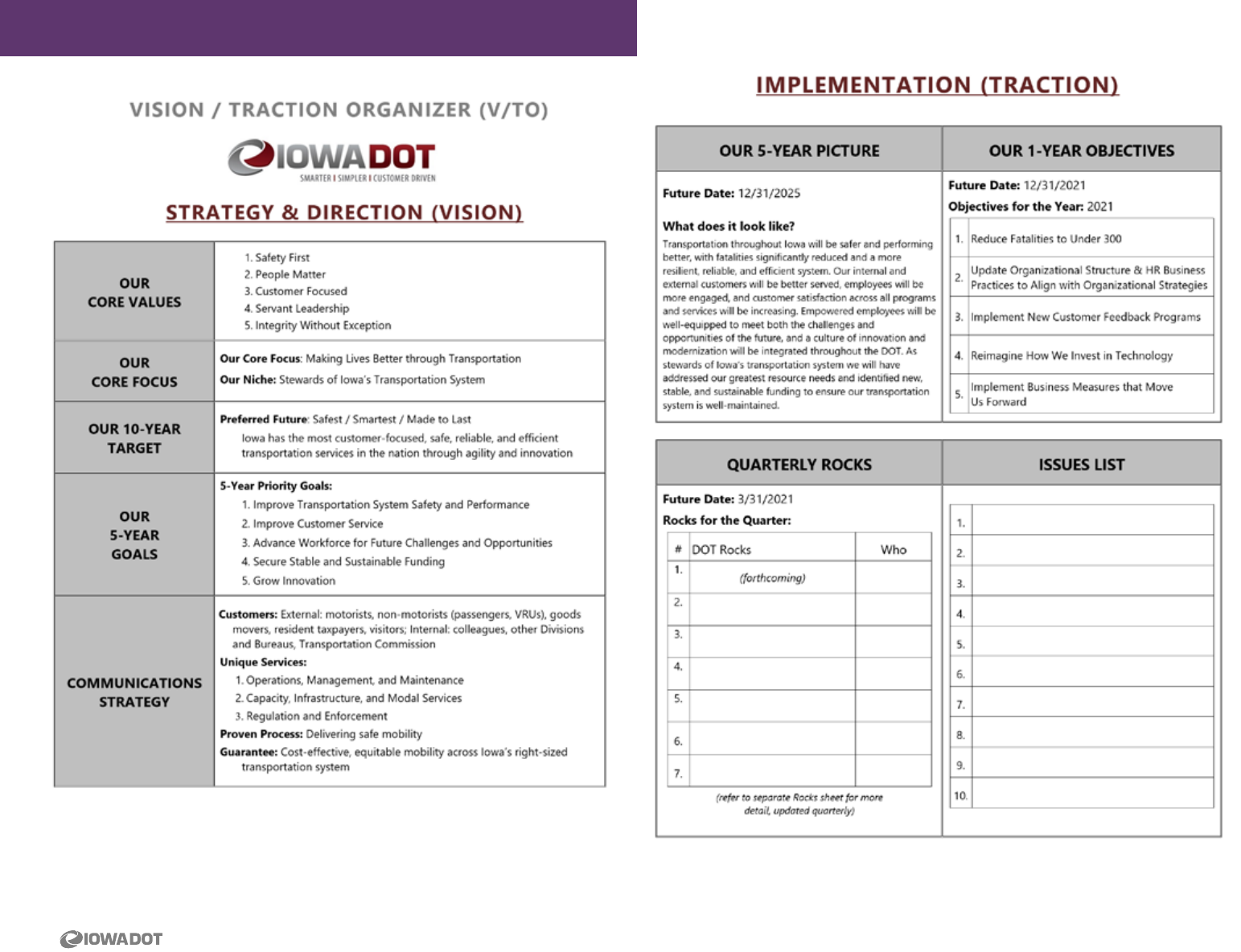
APPENDIX | 22
| BUSINESS PLAN | JANUARY 2021
APPENDIX

APPENDIX | 23
| BUSINESS PLAN | JANUARY 2021
APPENDIX
EOS Terms
Adapted from www.eosworldwide.com
1-Year Objectives: Denes your objectives for the year by identifying and
crystallizing your priorities, and measurables, along with your top three to seven
goals for the year.
5-Year Picture: A denition of what your organization will look like, feel like, and
be like in ve years. The 5-Year Picture creates a powerful image of the future and
helps everyone work towards the same vision.
10-Year Target: A long range, energizing goal for the organization, ranging from
ve years to twenty years out.
Accountability Chart: Dierent from an organizational chart, an accountability
chart denes the right structure and clearly identies who is accountable for
what.
Core Focus: Your Core Focus denes what you are as an organization to help you
avoid “shiny stu” and keep you focused on the areas where your business excels.
It comes from the intersection of knowing “Why” your organization exists and
“What” you do in the world.
Core Values: A timeless set of guiding principles that dene your culture and the
behaviors you expect from each other. They help you determine who ts your
culture and who doesn’t, and they help you attract like-minded people to your
team.
Data Component: Using a handful of numbers that give everyone an exact pulse
on where things are, and when they are o track.
Entrepreneurial Operating System (EOS): A proven set of simple, practical tools
that synchronizes how people in an organization meet, solve problems, plan,
prioritize, follow processes, communicate, measure, structure, clarify roles, lead,
and manage.
The EOS Model: Every organization comprises Key Components as depicted
by the EOS Model. Those components are: Vision, People, Data, Issues, Process,
Traction. These must be managed and strengthened to create a healthy, well-run
business.
IDS: Also known as the Issues Solving Track, IDS is the process your team uses to
Identify, Discuss, and Solve issues on an ongoing basis.
Issues Component: Strengthening your organization’s ability to identify issues,
address them, and make them go away forever.
Level 10 (L10) Meetings: A biweekly meeting with a specic agenda designed to
help you stay focused on what’s important, solve issues eectively, and keep your
team connected.
Communications Strategy: The denition of your ideal customer and the most
appealing message to attract them to your business. It should provide a laser-like
focus for your engagement eorts.
Measurables: When companies use EOS, everyone “has a number” that is
considered their measurable - something they do to contribute value to the
organization that is measured on a consistent basis.
People Analyzer: A simple tool that pulls your Core Values and Accountability
Chart together to help your organization identify if they have the Right People in
the Right Seats.
People Component: Getting the Right People in the Right Seats.
Process Component: “Systemizing” your business by identifying and
documenting the core processes that dene the way to run your business.
Rocks: The 3 to 7 most important things you must get done in the next 90 days.
Employees will typically have 1-3 individual Rocks each quarter while leadership
team members will typically have 3-7 individual rocks.
Scorecard: An EOS Tool used to track a handful of numbers that give you a pulse
on your organization.
SMART: Stands for Specic, Measurable, Attainable, Realistic, and Timely. Making
goals and Rocks SMART is essential for creating crystal clear communication and
for setting the right expectations between you and your team so everyone knows
what “done” looks like.
Traction Component: Bringing discipline and accountability into the
organization.
Vision Component: Getting everyone in the organization 100% on the same
page with where you’re going, and how you’re going to get there.
V/TO (Vision/Traction Organizer): A two-page document that helps your
leadership team dene, document, agree on and share the organization’s vision.

APPENDIX | 24
| BUSINESS PLAN | JANUARY 2021
APPENDIX
Iowa DOT Operating Handbook
Coming Soon
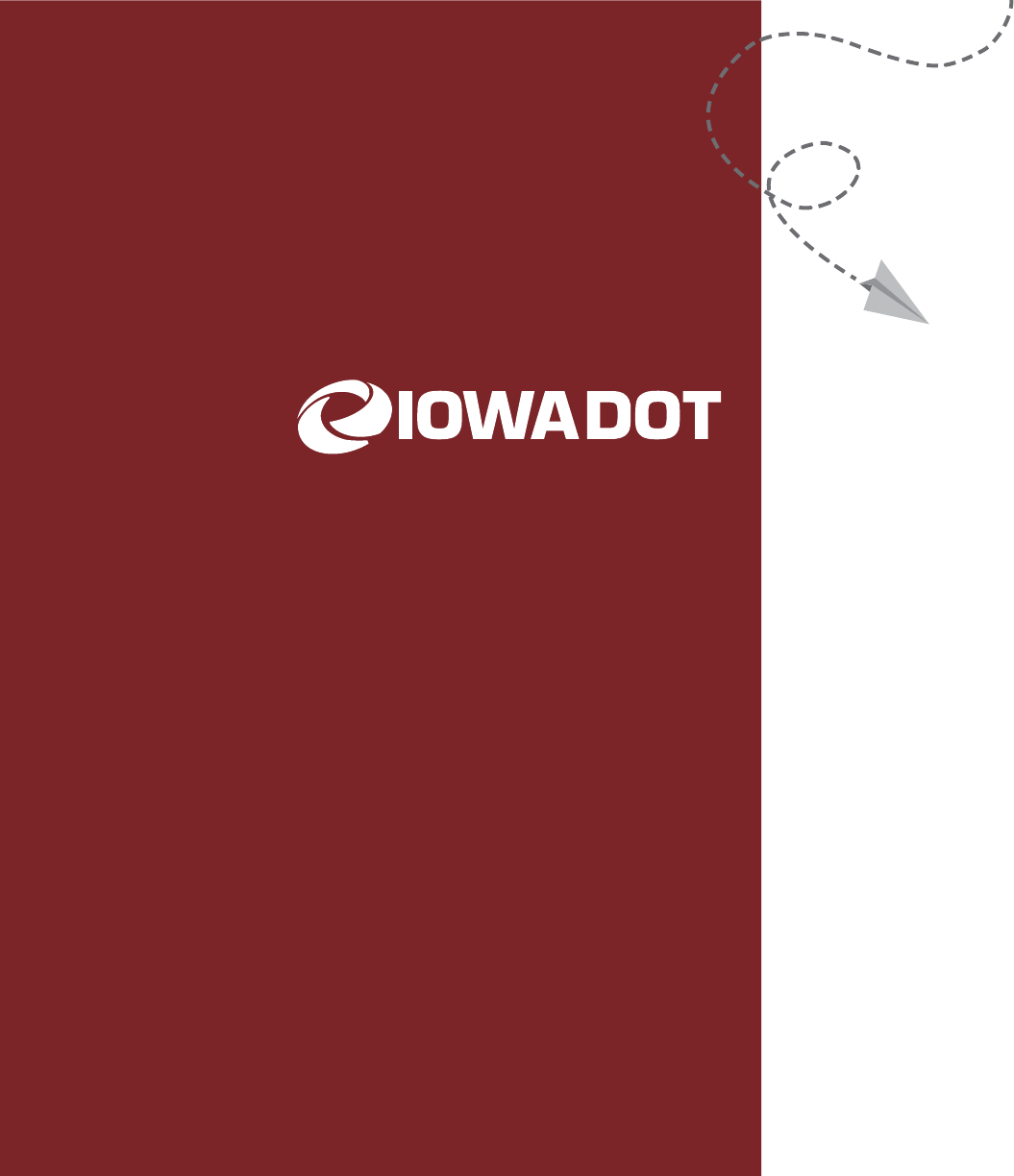
20212025
IOWA DOT
BUSINESS PLAN
MAKING LIVES
BETTER THROUGH
TRANSPORTATION
January 2021
